#Tel Afar
Explore tagged Tumblr posts
Text
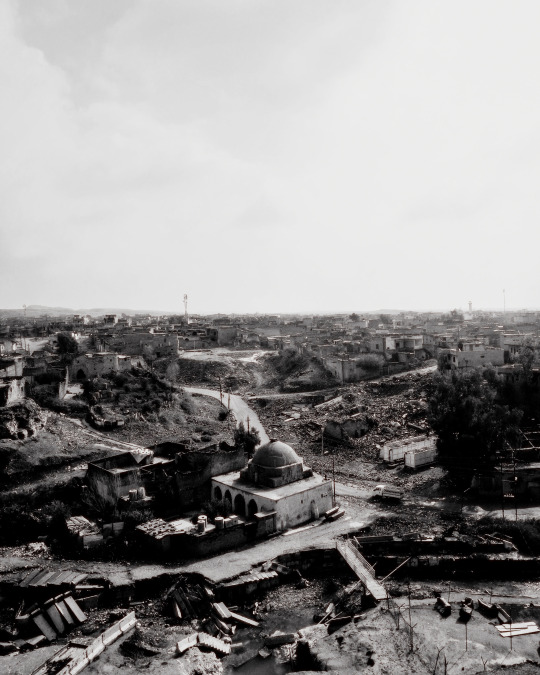
5 notes
·
View notes
Text
I had such a nice time wow. I’m so happy.
#e finally came over#and wowie what a guy#I swear to god I cannot keep falling for men and yet here we areeeeeeeee#I totally had a nice discussion with him and nothing else happened 😅#but yeah I think I’m in love with him so………..#kinda wanna shoot myself and yet I want this love to consume me?#if you couldn’t tel the sarcasm lol we fucked so hard but yeah I’ve been in love with this man from afar for like years#so like I guess dreams do come true girlies!!
0 notes
Text
Read Your Diary (FC43 x fem!reader)

Chapter 2: Own My Mind
CHAPTER SUMMARY: You might have finally admitted to yourself that you have feelings for Franco, but that doesn’t make the deep longing you feel for him any easier. And he's starting to make you question if he might feel the same longing for you, too.
WORD COUNT: 5.2k
WARNINGS: SEXUAL CONTENT 18+ ONLY MINORS DO NOT INTERACT. Reader is a lil freak, use of YN, mentions of anxiety disorders/therapy, reader has self esteem issues
TAGLIST: @scopeiguess
A/N: Thank you so much for all the love on part one! I never expected my first chapter to get any notes let alone over 200 notes in just a few days. Seriously every single note has me kicking my feet and turning my eyes into little heart emojis lol. I’m already about 2k words into ch 3 so I am hoping I’ll finish it before I have to travel for the holidays (I will not be able to write at all while I’m gone). Also, I had a request for someone to be tagged in this chapter, so let me know if you all would like me to start a permanent tag list. Anyway, I hope you all enjoy it!
Chapter 1 | Chapter 3 | Chapter 4 | Chapter 5

Oh it’s automatic, you know I just gotta have it
I’ll make your body a habit
You know there’s some kind of magic, uh huh
Do you wanna, do you wanna, own my mind, own my mind?
The Singapore Grand Prix was later that night. Franco did really well considering the circumstances. It was disgustingly humid, and when he was done you could tell he felt awful. You were so angry at everyone at Williams for letting him race like that. Yes, it was his job, but that was your friend out there suffering—your friend who you had just admitted to yourself yesterday that you were in love with.
You watched him from afar when he spoke to the media afterwards. His curls were plastered down to his forehead with sweat, and his skin was pale and clammy. You just wanted to hold him and tell him that you were proud of him. Instead you had to settle for keeping an eye on him in the chaos of the paddock post-race, and helping him back to the hotel with his mother.
She had to get on an early flight, so she left and you promised her you’d stay until he was okay. She was worried about him, and you were too. God, seeing him so sick broke your heart. You helped pack up his things while he took a cold shower and he emerged in just a towel wrapped around his waist. He seemed to be feeling much better thankfully, and his more playful mood reflected it.
Of course, you snuck a glance or two at his sculpted form. Just a peek at his wet curls, the water droplets running down his chest—even the scar on his collarbone that he always tries to hide. He thinks it’s ugly. You think there isn’t a single part of him that’s ugly.
You tried to ignore him and continued tidying up. “I hope you don’t expect me to tip you,” he joked.
You playfully rolled your eyes. “What else are you going to do with all your stripper money?”
“Well, if we’re stripping…” he said, slowly lowering his hand down to his hips, palming the towel. You stomped to the bathroom, out of view of whatever joke he was making. “Get dressed, you man whore,” you instructed.
You lived for the banter you all had—at times, it felt like your own language separate from the rest of the world. The audience could hear Franco’s humor, but they’d never understand it like you did.
When you left the bathroom he was thankfully (or, unfortunately) fully clothed, lying on the bed and lazily scrolling through his phone.
“I’m glad you seem to be feeling better,” you said.
“Well, better than I was, but still kind of like shit,” he responded with a sigh.
“Well, you can get some rest, I’ve got you pretty much all packed up so you’ll be ready to go tomorrow.”
He put his phone down and gave you a soft smile. “Thank you.” He paused for a moment, as if he was readying himself to say something, and looked at the floor away from you. “YN, would you… stay? Just in case I get worse, you know.”
You could tell by the color in his face that he was feeling better, but how could you deny him this small comfort, when his eyes met yours through his long eyelashes, a sliver of light from the street lamps outside cutting through the drawn curtains and resting on his face? He was so beautiful. And he wanted you to stay.
“Of course,” you said. You were going to get up from the corner of the bed where you now sat and move to the chair until he fell asleep, but instead he motioned for you to lay down on the bed next to him. Tentatively, you did, heart racing as he laid his head on your shoulder and curled his body into you.
His playful flirting was normal, but this was… different, a closeness beyond what was usual between you two. You could feel the warmth of his skin, his breath steady against you. Yes, your heart was beating, but you felt strangely calm. Peaceful. In this moment all that mattered was you and your best friend, quietly sharing a moment in each other’s presence.
Your hand, trembling, reached down to smooth a piece of his hair. He hummed in response, to which you quickly moved your hand, mumbling, “Oh, sorry.”
He just grabbed your hand and wordlessly placed it back on his head. Slowly, you began to run your fingers through his beautiful curls. You got lost in the moment, and soon enough, you felt his breath even out as he fell into a peaceful sleep. Soon enough, the stillness of the moment and the soft rise and fall of his breathing lulled you to sleep too.
You woke just as the sun was beginning to illuminate the sky outside. You had an unfortunate habit of waking up in the middle of the night—a common symptom of anxiety, your therapist had told you—but for the first time in a long time, you slept through the night soundly.
You and Franco had shifted, and he know had his arm lazily wrapped around you. You remembered the previous night and felt your heartbeat increase. It wasn’t just the feeling of his arm draped across your waist, but the feeling of…. something else. A little… morning problem.
Of course, you knew Franco couldn’t help it. He wasn’t even awake, and from your years of friendship you knew how much of a heavy sleeper he was. It was just an uncontrollable biological phenomenon. Nothing more.
But you couldn’t stay, feeling him pressed against you like that. It felt wrong and you were so nervous you could hardly breathe. So you carefully wiggled your way out of his grasp and quietly left his room, returning to your own.
Returning to your hotel room, all you knew to do to calm yourself down was to write. So you opened your journal and wrote all about the scene; the dinner, the banter, waking up next to him in the morning sunlight.
You wrote until your hand started to cramp. Then you went back to read what you had written, skimming over it, your mind only picking up on little snippets.
Lily thought I was Franco’s girlfriend, and I guess I can’t blame her. He’s such a flirt, I love and hate it. I just wonder if it ever means anything to him. I mean, he treats random reporters the same way he treats his girlfriends. What does he do when he actually wants someone?
He asked me to stay. I thought he must still be sick, but he just wanted me to… cuddle? I ran my fingers through his hair until he fell asleep. He looked like an angel, so soft and innocent, resting next to me. I wanted to kiss him so badly.
But when I woke up, I could feel his morning wood pressing against me. God, it was so awkward. But I can’t stop thinking about it, what he would do if he really wanted me.
Oh no. Oh no no no. You shouldn’t write that kind of stuff. Having a crush was one thing, but thinking about him like that? It was…wrong. Franco was your best friend. Your best friend who was absolutely perfect—yes, physically as well.
You threw your journal on the bed with a grunt of frustration.
You were fucked.
Your heart beat nervously as you walked into the waiting room before your next therapy session. It had been a week or so since Singapore when you had finally admitted the truth to yourself.
Yes, you had feelings for Franco. Emotional and… physical. No, you had no idea what to do with them.
Waiting for the clock to strike the hour, you reached down into your bag to run your fingertips along the spine of your leather journal. You had been writing incessantly in it since that night.
And if you thought that your fantasies were bad then, oh, it had gotten so much worse.
You told yourself you couldn’t help it. You were ovulating. You’d been single for a while. You were a girl with needs. But you felt disgusted, basically writing porn about your best friend.
I keep imagining that night at the hotel in Singapore, when he came out of the bathroom with just his towel on. In my mind, he sits on the edge of the bed like always, hand carefully placed at the top of his towel. His hair is dripping and his skin is still dotted with water droplets.
He doesn’t even have to say anything. The way he looks at me—eyes looking up through his gorgeous lashes, his pouty lips looking so lonely—I know exactly what he wants. So I get on the bed and straddle him, the only thing between us being my skirt, panties, and the thin fabric of the towel. I can feel him, how badly he wants me.
Then I’m in control, kissing his neck, leaving love bites up and down so that everyone knows he’s mine. He moans softly into my ear, bucking up his hips into me for just a bit of friction. “No,” I tell him, “I didn’t give you permission for that.” He whines in protest, but I just smile at his frustration. “My sweet boy…”
Even remembering what you wrote felt filthy. You wanted him—all of him.
I had a dream last night that Franco dominated me. We are in his apartment, arguing about something stupid, and he pushed me against the wall, kissing me roughly, like he couldn’t get enough of me. He holds me waist with his strong hands as his kisses get deeper.
“I need to taste you,” he growls into my mouth, picking me up and throwing me on the bed. Before I can react he’s on top of me, one hand holding my chin and the other fumbling with the zipper of my jeans. “Are you going to be good for me?” he asks, and I frantically nod.
“That’s what I thought,” he said, smirking, as he pulls off my jeans and my panties with it—
“YN? You can come in now.” You’re pulled from your daydreaming by the voice of your therapist. You close the journal, embarrassed, but not without her seeing it in your hands.
“I hope you’re doing well. I see you’ve got a journal, you’ve been writing in it, I take it?” she asked as you sat down in the familiar office.
“Yeah, I have,” you answered, clutching it tightly in your folded hands.
“Well, that’s great! Has it been helping you?”
“Um… I guess?”
“Explain more.”
You paused, unable to think. All you could do was blurt out the truth.
“I’m in love with my best friend.”
“…Okay.” Your therapist also paused. “Did your writing bring about this revelation?”
You tumbled through the rest of the session, trying to explain what happened without revealing too many intimate details.
“I just feel… horrible I guess. It’s so dumb. It’s not like he’ll ever feel the same way about me.”
“What makes you think that?”
“Well, he’s so… perfect. And I’m an anxious mess,” you laughed.
“Is anxiety that much of a barrier to being loved?”
You laughed, considering the gravity of her question. You couldn’t truly answer it. “It shouldn’t be. But I just know he’d never choose me and that’s okay. He doesn’t even know how I feel, and even if I had the courage to tell him, I wouldn’t want to ruin our friendship.”
“Does it bother you, not being able to tell him about all of this?”
“….yeah, it does, actually,” you admitted. "I'll never do it but... I just wish I could, you know?"
"I understand. Why not start with expressing your feelings platonically? Telling him what he means to you as a friend?"
"I guess I could do that." You didn't quite know how you'd accomplish that, but you weren't in therapy just to refuse to try anything. You wanted to do hard things. You needed to do them.
So you made it your mission, next time you saw Franco, to tell him something meaningful. You weren't sure what it would be or how it would come out, but you'd at least try.
Unfortunately, it was a while before you'd see Franco again. There were a few weeks between Singapore and Austin, and between race prep with Williams and sponsorship deals, Franco was up to his ears in work. You still talked, of course—you texted back and forth every day—but it just wasn't the same, and you missed him horribly.
You'd felt this before, the ache in your stomach that longed for his presence when you'd gone too long without seeing him. You figured it would be different now that you had finally admitted to yourself what this feeling was. You didn't expect it to be worse.
Because now that feeling in your stomach was sharper. You didn't just yearn for the mere concept of him—you wanted everything. You missed his smile. You missed hearing his voice rise and fall in intonation as you bantered back and forth. You missed his perfect curls smoothed across his forehead. You missed the feeling of his arm wrapped around you, whether in a friendly embrace or something more intimate, like you'd had in Singapore. And in the back of your mind, you missed the feeling of Franco's hardness pressing against your back, a sign of what you fantasized was a deep wanting for you, both physical and emotional.
You tried, and failed, to rein in these fantasies. But with the more days that passed, the more Franco began to feel less and less like your best friend, and more and more like the version of him you'd created in your head, desperate for you more than anything else in the world.
You wrote all of this down, of course. If you hadn't you would have lost your mind with lust. Romantic pining was nothing new to you—you'd had a boyfriend before, although what you felt for him paled in comparison to Franco—but this intense physical desire you felt was new.
You had never been satisfied by anyone, anything, before. You smiled to yourself as you thought, well, I guess it's true what they say about the quiet, shy ones.
And Franco, unbeknownst to him, wasn't making it any easier. He called you one day, the first phone call you'd had in a while, a few days before you'd be flying out to Austin for the grand prix.
"I'm sorry I've been so busy," he explained, "but the stuff we're doing is so cool."
"Am I allowed to know, or is it top secret?" You smiled through the phone.
"Well... I can't tell you everything just yet, but I can give you a sneak peek. Check your messages."
You felt your phone vibrate, receiving a notification from Franco. You tapped on the text and nearly dropped your phone. He had sent you unedited pictures from a photoshoot, and he looked fucking amazing.
His voice on the other end of the line explained, "I'm gonna be on the cover of Forbes Mexico for the race. What do you think?"
At first, you were quite literally speechless. "Franco, you look..."
"Gorgeous? Sexy? Like the most fuckable Formula 1 driver?" he teased. For a split second, you wondered if it was possible to hear a blush through the phone.
His banter inspired your own. "... not bad. I mean, you certainly give them a lot of work to do to make you look good, but they did pretty decent."
If human beings could hear a blush through a phone, you were sure the noise that Franco made would be indicative of one. "Oh, shut up and tell me I'm pretty."
A million potential responses went through your head. Make me. Beg for it. My pretty boy.
Instead you just laughed and said, "No, really, you look great. This is amazing. You know the entire internet is going to lose their minds after this drops?"
He smiled. "That's the plan."
It still hadn't been released by the time you made it to Austin, but you weren't complaining. A part of you liked having this piece of Franco all to yourself. You kept going back to the photos again and again—his glare at the camera, his arm draped over a steering wheel—you couldn't get enough.
And when he met you at the airport in Austin (even though you told him it wasn't necessary), all that want came rushing back the instant he wrapped you in a hug that lasted a little too long to be considered platonic.
You couldn’t let your thoughts go that far. You’d already crossed a line by allowing yourself to feel such… intimate emotions for him. But to even imagine that he really wanted you to? No. That was where you actually drew the line.
But unfortunately, Franco’s confusing behavior made it far too easy for you to believe that he didn’t feel the same.
You all didn’t talk about that night in Singapore, or the fact that he must have woken up alone. You’d rather throw yourself into a pit of knives than talk about it and have to bear the embarrassment, and Franco didn’t seem bothered at all, so you let it go to the back of your head, acting as if it never happened at all. Your first day in Austin was fine, mainly spent recovering from jet lag and exploring the city on your own while Franco did his media duties. You had dinner with him that night and it was like no time had passed. The banter was the same, the atmosphere was great, and you were so happy to be back in his presence again.
As he walked you to your hotel room, you remembered your promise you had made to yourself, that you’d try to practice being vulnerable. For some reason, you didn’t have it in you today. You were tired, in a good way, but all you wanted was to curl up next to Franco and wake up in his arms the next morning.
And of course, you assumed Franco would want to stay. Why else would he walk you back to your room? Maybe it was the nervousness of the implication—you and Franco, alone in your hotel room—that prevented you from saying anything, or maybe you just knew that now wasn’t the right time.
Either way, there was no moment. Franco just bid you goodnight with a wave and left to his own room.
You didn’t know what you were expecting. He just didn’t like you like that, and it was okay. You didn’t want to ruin the friendship.
But you also couldn't help but feel a bit...disappointed. You cursed yourself for letting your fantasies become too real. It would be weirder if he had tried something.
Still, you dealt with these complicated emotions the only way you knew how: writing. You opened the journal and began to write away, not even stopping to think, just vomiting words on the page.
We're in Austin right now. It's been...normal. Good. Which is weird, considering that last time we were at a grand prix we spent the night together. It's not like that, but I can't help but think that something is just...different. I keep thinking about what my therapist asked, about anxiety being a barrier to love. Franco has always supported me, or tried to at least. I haven't exactly made it easy for him, or anyone else, since I bottle things up so much.
But he doesn't love me, not like that, anyways. He dates models—I mean, God, he is a model now—and I'm just me. I'm not exceptionally pretty or smart or funny. I'm nobody.
I can't help but fantasize about how things could be different. I imagine us going on a fancy date. He's wearing that suit he did the Mexico photoshoot in, with the top shirt buttons undone to tease me. He picks me up from my apartment at 8 with a bouquet of pink roses (not red, red is too cliche; but I guess I can't complain, no man has ever bought me flowers). I'm wearing that dress I got the last time we visited Argentina together—the one that hugs all my curves just right, and it's his favorite color. The dinner is sweet. We savor the time together, since it's more scarce now that he's a permanent driver in F1. We've had a few glasses of wine, just enough to get us slightly giggly and blushed, our inhibitions long abandoned. In the back of the Uber he traces his hand up and down my thigh, each time teasing scandalously closer and closer to the place I need him the most.
The ride is torturously long, but when we arrive back at his apartment, he wastes no time in getting me alone so he can have his way with me. He picks me up bridal style and kisses me through my drunken laughter, a smile on his face, too. He lovingly tosses me on the bed before taking off his jacket. I just look at him in awe. He’s so fucking perfect. And he’s all mine. He gets on top of me, kissing me gently, and no words need to be exchanged between us. I can feel the tenderness of his lips against mine, and he pauses, looking me directly in the eyes. The moment is quiet and I feel so safe and loved with him, until our lips crash together and his hand finds its place on my thigh again. It trails up and
There was a knock at your door.
You jumped, startled. Getting up and looking through the peephole in the door, you saw it was just, of course, Franco, so you hurried to open the door.
“Hey, what’s up?”
“You left your lipstick in my pocket,” he smirked, holding out the tube to you.
“Oh!” you exclaimed, having forgotten about asking him to hold it earlier at dinner since your outfit didn’t have pockets.
“You didn’t even notice that I stole it.” It was true. You had completely forgotten about it with all your journaling.
“Well, the shade would look good on you,” you teased.
He playfully rolled his eyes. “It’s no fun pranking you when you don’t even notice. Keep up, hm?” Franco loved to play little tricks on you like this, and usually you played right into them, knowing that the fun of his taunting outweighed whatever consequence the prank itself would bring.
“You’re impossible,” you said, smiling regardless. “Now, if you’re done stealing my stuff, I’m exhausted.” You went to close the door, assuming this to be the natural end of the exchange, until Franco took a step into your room and rested his weight on the doorframe.
“Not exhausted enough to skip your… journaling?” he said, looking over your shoulder.
Shit. Shit shit shit. You hadn’t closed your journal.
“Since when do you journal?” he asked, leaning forward as if he was trying to make out the words from across the room.
If you had been smarter, smoother with it, you probably could have lied and said it was for work, then proceeded to rant about your remote corporate job which would have bored Franco to tears. But smart and smooth with it are two things that you are not.
You swiftly turned around to grab the journal and slam it closed, holding it in a death grip. Your absence from the door, however, had been interpreted by Franco as an invitation to come in. And it was clear by the urgency of your actions that whatever was in that journal was something you did NOT want him knowing.
You answered him, “I haven't been doing it very long.” There was a brief moment where you considered ending the conversation there. It was too late to formulate a good lie, anyway. But on the other hand, you wanted to do hard things and be honest with yourself and others. So you did. At least your therapist would be proud.
So you continued, “It was a suggestion from my therapist. Just helps you get your thoughts out so they aren’t all stuck in your head.” Simple enough. It was the truth, after all. He didn’t need to know what those thoughts were.
“Can I read it?”
You paused in bewilderment. “Um, no? Franco, what the fuck?”
“What?”
“You don’t just… ask to read someone’s personal journal.”
“Why not?”
“Because it’s personal, you muppet!”
“Really? Stole that one from Lando?”
“It fits." You snorted. "But seriously, why would you ask to read my journal?”
“Because I never know what you’re thinking. You’re impossible to figure out.”
“... I am?”
“Yes, you are.”
“Well why don’t you just, I don’t know, ask me what I’m thinking?”
“... I know you did not just say that.” He made a face at you. Yeah, he was right. If you were skilled enough at communicating your emotions you wouldn’t have needed to start the journal in the first place. He continued, “You were literally dying in Singapore and when I asked you what was wrong you said you were fine.”
“Hey, I made it to quali alive,” you replied.
“Look, I just… It would be nice to understand where you’re coming from a bit more, like… actually nevermind, forget I ever said anything.” Your confusion only lingered as Franco clearly struggled to find the words. You guess that this was how he felt communicating with you sometimes—it sucked.
“Whatever, you weirdo,” you said, your joking tone an indicator to him that you were willing to act as if this horribly embarrassing exchange had never happened.
“Goodnight, YN,” he said as he left the room, ending the conversation like that. Now it was your turn to be confused by his actions. There was something he clearly wanted to say but couldn’t, and you let yourself wonder, just for a second, if what was happening to you wasn’t so different from whatever was going on in his head.
You let your fantasies lull you into sleep.
Again, you let… whatever was happening between you and Franco go unsaid and focused on supporting him for the grand prix.
From the Williams garage, you cheered him on as he got another point, overtaking Alonso so skillfully. When he came back to the garage, you met him as you always did, with a smile that stretched across your entire face. Your hug this time was different, as he picked you up and twirled you around. You laughed into his shoulder, holding on to him as he spun you.
He put you down and was immediately assailed by hugs all around from the Williams team. Lily, who had been in the garage by your side the whole race, elbowed you in the side.
“So, you and Franco are just friends, huh?” she teased. You all had become friendly enough that a little bit of banter was acceptable.
You inhaled with a soft smile, watching him celebrate in the distance. Once again, you chose vulnerable honesty.
“Yes, we’re just friends. But it’s…complicated.”
Her eyes widened and she turned to you, shielding you off from the celebratory scene. In a lowered voice, she muttered, “You have feelings for him?”
“Is it that obvious?”
“Unfortunately, yeah. But c’mon, he just spun you around like a Disney princess. He obviously has feelings too. And have you seen what the fans are saying about you all?”
“No?” You were surprised the fans even knew you existed. You had cut down on social media a long time ago, knowing how much it contributed to your anxiety and self-esteem issues. You still had accounts, but all were private and hardly used, and you didn’t interact much with fans at the races, preferring to stay in the garage or in Williams hospitality to enjoy the races without worrying about what people were thinking of you.
“They love you two. Seriously, I think there’s gotta be a million teenage girls living vicariously through you.”
You laughed at her comment, not in a mocking way, but because of the absurdity of it all. None of these people really knew you, or Franco, for that matter. It just proved your point that social media wasn’t real.
So if people on social media were shipping you and Franco, then it couldn’t be true. At least, that’s the confusing logic you held yourself to. A line had to be drawn somewhere.
Your conversion with Lily was cut short by Franco approaching. “Celebratory dinner later?” he asked, still beaming. You agreed.
If you could have bottled the energy that Franco exuded all day after the race, you would have had yourself a very lucrative energy drink company. As he was packing up his things to leave the circuit, you all passed by barriers where fans were practically crawling their way to get to him, screaming his name and waving Argentine flags in the air. He tilted his head to them as you passed, and asked, “Can I?”
You were in no rush, and of course you could never deny him this moment to enjoy what he had built with all his hard work. He stopped to sign shirts and caps while you stood behind. Everyone had their phones out, filming Franco, but you knew you’d inevitably end up in the background. You just hoped you didn’t look too awkward.
Franco turned his head back to you as the crowd behind the barrier just grew more and more excited. “You see this, YN? This is insane!” his smile stretched from ear to ear, and you just smiled in response. He climbed up the fence, eliciting a small giggle from you, and filmed the crowd below him chanting his name.
You had never been more proud of him. And you had to say it.
So you did, after dinner when you all somehow ended up in his hotel room together again. The atmosphere was…calm. Familiar. Warm.
The conversation had reached a natural pause, and the night had gotten to that point where that space between you and him felt simultaneously infinite and nonexistent.
He sat crossed legged on the bed, fiddling with something in his suitcase next to him. You sat on the chair only a few feet away.
“I’m so proud of you, Franco. I don’t tell you enough.”
He looked up and your eyes met. And he blushed. You had made Franco Colapinto blush.
“When did you get all sappy on me?” he asked. There was still a bit of a wall up. It was unusual for you all to be this vulnerable with each other.
“Since my best friend in the entire world is achieving all his dreams! I mean, we’re celebrating points now, but one day we’ll be celebrating podiums. And then race wins. And then championships. I believe it.”
The room was draped in a thick silence. Franco knew you didn’t throw these words around carelessly. And the unspoken implication, that you’d be there for all of it.
“I believe it too,” he said quietly. There was no ego in his statement. Only true hope.
#formula 1#f1#formula one#formula 1 x reader#formula 1 fanfic#f1 fanfic#formula 1 fic#f1 fanfiction#franco colapinto#franco colapinto x reader#fc43 x reader#anix fics#fc43#franco colapinto fanfic#franco colapinto fic#franco colapinto x you#f1 x reader#f1 x you#f1 x y/n#franco colapinto fanfiction#maneskin#Spotify
307 notes
·
View notes
Note
hi!! how are you? i hope you are having a lovely day and staying hydrated.
i just would like to request a tobio x fem!reader where reader is the younger sister of oikawa and because of the "bad blood" between the two, she gets tired and lectures them about how they should stop their petty fight and, at least, be civilized with each other. (though oikawa is mainly the petty one 😂)
it's a bit messy, so it's okay if you don't decide it or completely change the plot.
btw, i absolutely love your fics!!! and i definitely am a fan of yours!!!
𝐁𝐢𝐜𝐤𝐞𝐫𝐢𝐧𝐠 𝐅𝐨𝐨𝐥𝐬
ᴋᴀɢᴇʏᴀᴍᴀ ᴛᴏʙɪᴏ x ꜰᴇᴍ! ʀᴇᴀᴅᴇʀ
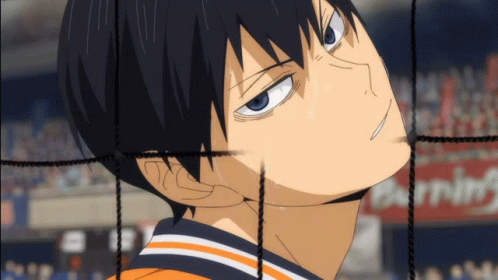
The Karasuno Boys volleyball team were excited to be invited to the Karasuno’s Girls volleyball tournament. The tournament was called ‘Spring Days’, it was showcasing the popular teams of Japan and they couldn't wait to see all the cute girls there.
Then they were all smacked in the face when Kageyama offhandedly said that he wouldn’t be there to support the Karasuno girls.
“What do you mean you’re not going to support them! They always support us!” Hinata shouted at his grumpy teammate. The orange haired male was currently shaking the life out of Kageyama.
Then Kageyama scowled and began wrestling Hinata as he said, “Because I would be betraying someone important to me. She plays for Shiratorizawa.”
“Eh?” Hinata stopped shaking Kageyama and just stared at him blankly while being held in a chokehold by said male. Then he whispered so the rest of the boys practicing wouldn’t hear them, “Someone important? Like a girlfriend?”
“Is that a problem?” Kageyama casually asked, pushing Hinata away. He picked up his drink and started gulping down the water in his plastic bottle. He wiped his mouth with the back of his hand and shrugged his shoulders, “It’s a good thing I get a free ride there, but don’t expect me to cheer for our school.”
“We are there to support our team, Kageyama,” Sawamura crossed his arms over his chest and glared down at the young teen with his dad stare, “And if I don’t hear you cheer for them, you will not set for two games- no three games.”
Kageyama deflated and looked off to the side in thought. You would understand the punishment he was getting and would want him to do what’s best for him. But your attitude was going to be different during the game. “Fine, but if our school faces Shiratorizawa, you’re gonna wish I cheered for her instead.”
The boys watched as the volleyball nerd went over to the net getting ready to practice some sets. They had no idea what he meant by that and left to join him for practice.
…..
Saturday came quicker than the boys anticipated, nonetheless they sported the Karasuno jackets and walked into the large stadium with giant smiles on their faces. They all loved the feeling they got walking up to the court, so sometimes it was weird for them to be watching and being the supporting students.
Kageyama was glued to his phone, messaging his girlfriend non-stop. Hinata would definitely peek over Kageyama’s shoulder, but he would always be pushed away with a hand in front of his face. The boys were seated in the first row and had an amazing view of the court.
Kageyama was doing perfectly fine until he heard his rival speaking from afar. “Ah, the poor little trashy crows have to play against my amazing little sister. I can only imagine how giant the point difference is going to be.”
Kageyama looked to his left to see two empty seats. That was until that annoying voice still praising his sister got closer. His dark blue eyes looked up to see brown ones glaring at him. Then another male popped up from behind the curly brown haired person.
“Ah, Kageyama, you’re here to support [Name] as well?” Iwaizumi asked, walking in front of Oikawa and greeting the stumped black haired male.
Kageyama bowed his head then said, “No, I’m not allowed to cheer for her or else I won’t be a setter for three games.”
Iwaizumi sat down next to him and chuckled, “I get it and I’m sure she would as well. Did you tell her?” The older teen got comfortable and looked at his old teammate.
“I’m afraid she’s going to give the Karasuno girls a hard time if I did,” Kageyama admitted with his eyes directed hard at the ground.
A loud laugh caught their attention and Oikawa leaned back into his seat with a smug smile on his face. “[Name] is so going to crush your trashy team solo! If I were you, I would tell your other halves to forfeit now.”
Iwaizumi elbowed Oikawa’s rib cage causing the male to lurch forward with a holler. Before Kageyama could agree with his rival, his loud teammates came into the picture with heated glares, “What makes your snotty sister so special, huh?” Tanaka shouted while Nishinoya stood behind him with a fist in the air, “Ten bucks, our team does the crushing instead!”
“Deal!” Oikawa shouted back with one hand holding his side while Iwaizumi shook his head from the lack of awareness these idiots had. The usually grumpy male leaned over to Kageyama and whispered, “You do know that your team is going to make trashykawa super rich after this game?”
Kageyama crossed his arms over his chest and grumbled back, “I tried to warn them.”
“Welcome all to the Spring Days tournament where talented ladies from all over Japan showcase their volleyball skills.”
The female announcer excitedly proclaimed in her microphone. The males couldn’t focus on what she was saying because a new group arrived behind them and this group wasn’t going to go unnoticed.
“Oh my, is that Oikawa Tooru? The big brother of our baby eagle, [Name]?”
Kageyama peeked a glance at his rival and saw the instant disgust on the male’s face which caused a bit of happiness to appear on his own face. Kageyama thought this was a perfect karma moment for the smug male.
“You do well to address my little sister by her last name. Just because she trains with that guy, doesn’t mean you cannot show her or myself some respect!” Oikawa pointed at a very tall third year student.
Ushijima looked down at Oikawa with his eyes and stated, “Your sister likes the nickname the team gave her and she has all our respect because of her skills. At least she took my advice to join the girls team at Shiratorizawa unlike you. She’s being nurtured if that’s what you care about.”
“Don’t word it like that, it makes you sound like a pervert! Also that’s because I don’t want to be your teammate! You’re the one that brainwashed my poor sister! I should have persuaded her to spend her time elsewhere!”
“What, like Karasuno?” Tendou snidely said with a snicker.
Kageyama could feel the tension from his captain and vice captain as Daichi spoke up with a fake smile on his face. The third year Karasuno male turned around and asked Tendou with that cheap smile, “Something wrong with Karasuno?”
Tendou hummed and shrugged his shoulders, “Ehh~ You don’t really see people with skill choose Karasuno unless they’re rejects,” He looked at the back of Kageyama’s head, “Or useless dreamers.” He stared at the rest owlishly.
“That’s enough out of your mouth,” Semi joined in and told everyone to focus on the game which is about to start. Everyone had their feathers ruffled up in some way and it was because of their snide remarks to one another.
“For our first game, we have Karasuno vs Shiratorizawa! Please welcome them to the court!”
Kageyama pulled out his backpack from under his chair and everyone looked at him suspiciously. He didn’t pay attention to their questioning glares as his eyes were on a girl who looked around the arena for him. Of course, your knees were not covered by your usual white and purple knee pads.
It only took another minute for you to find him and you ran over to the stands with a giant grin on your face.
“Tobio, thank you so much for bringing them! I forgot I left them at your place!” You huffed out and sat down in front of his backpack digging in it without any permission. You found your knee pads and took them out with a sigh of relief. “You just saved me from running ten laps back home.”
“It’s no problem at all,” Kageyama responded with a gentle smile on his face as he admired your look. The rest of his teammates were baffled by the look of his face and how pretty you were. You seemed kind, way kinder than your older brother.
You slipped your knee pads over your shoes and comfortably on your knees. You looked up at Tobio and blushed at the soft look he was giving you, but you could tell he wanted to tell you something. “Is something wrong, Tobio?”
“Yes!” Your brother shouted standing up from the bleachers, “He’s not going to cheer for you! But don’t worry, you have me!”
“And us!” Tendou shouted from a row behind. You laughed and pushed yourself up from the floor. You weren’t going to tell them that you didn’t notice them because of your attention to your boyfriend.
“Is there a reason why you’re not going to cheer for me, Tobio?” You asked with a pout on your face and he stood up immediately to comfort you. You loved this about him, he was pretty shy, but he made sure to keep you happy.
He looked at his team then to you and explained, “They didn’t believe me when I said that my girlfriend plays for Shiratorizawa and said that if I didn’t cheer for the Karasuno girls then I wouldn’t set for three games.”
You laughed and gave Kageyama a quick hug pushing him gently back onto his seat, “Eh, don’t worry Tobio. I was just teasing you. I know I will always have your support! Anyways, what’s the bet?”
“You know about the bet?” Hinata questioned bewildered by your psychic abilities and you scoffed with a smirk on your face as you gestured over to your older brother, “Please, if my brother doesn’t force someone to bet on my skills then he’s not my Tooru.”
“We bet ten dollars,” Oikawa said and leaned back while Iwaizumi shook his head in exaggeration.
Then you rolled your eyes and fixed your knee pads a bit while saying, “I would have gone higher, older brother. But that’s okay, I hope to see you all in the finals.” You winked at Kageyama and shouted over your shoulder as you walked away, “I better not hear the both of you talking smack to one another. It throws me off my game!”
Oikawa sat back in his spot and glared at Kageyama, “Why were her knee pads at your place?”
Kageyama shrugged his shoulders and zipped up his bag. The words from you not even seconds ago being forgotten because of a cruel idea in his head. He was tired of Oikawa and this was for sure going to get him riled up.
Kageyama turned his head and smirked at Oikawa, “Maybe because she spends most of her time on her knees.”
“I dare you to say that again!” Oikawa shouted while being held back by Iwaizumi who had to hide his blush from his former teammate. He wasn't expecting Kageyama to be that bold!
“I meant what I said!” You shouted, giving a glare at your rambunctious brother.
..........
Thank you for your support and I hope this was a fun read for you because I had fun writing it!!
#x reader#anime imagine#manga imagine#x female reader#haikyuu imagine#haikyuu#kageyama tobio#kageyama tobio x female reader#kageyama imagine#tobio x reader
124 notes
·
View notes
Text
NUMBER ONE GIRL
15. ask her out (written)
prev // m.list // next


Your eyes take a few seconds to adjust to the neon lights and the smell of alcohol, smoke, and even sweat hits you in a way that makes you want to cover your nose but something far more interesting catches your attention.
Lee Minho is holding your hand and guiding through the ocean of people to the VIP area where the rest of your friends are already settling. As soon as you teach the table, he lets go of your hand and, even though you don't know why, you feel kinda annoyed.

Between laughing and drinking, your friends start to wander off and, before you know it, Minho is at your side. "Is something wrong?" He asks getting close to you.
"I'm just kinda tired and I don't exactly feel like drinking so everything seems a little too much right now," you answer honestly. You're not sure if he heard you, but he suddenly gets up from the table and offers you his hand.
"Wanna dance with me?" He asks. "You don't have to be drunk to have fun and, weird enough, dancing is a great way to get an energy boost."
"That sounds like a lie," you say as you get a hold of his hand and stand up.
He guides you to the dance floor and you find yourself having a good time. He's fun in a very sarcastic, and kinda mean, way; he makes you laugh. You missed laughing with someone other than your friends. You're not sure why but you just can't see Minho as your friend. He keeps laughing and smiling and making small talk, just everything a friend does. But to you it feels different.
A few hours ago, you realized something; you do know why, but it doesn't make any sense. You have a crush on Lee Minho and it scares you. Not because he's weird or mean, but because you don't know him at all. He's been somewhat nice to you for less than a week and now you have a crush? Are you really that touch starved? It makes you feel pathetic and silly.
You know you don't miss Sunghoon, at least not in an 'I-want-you-back' kind of way, but you still have some unresolved feelings about the whole cheating and break-up thing so now is definitely not the time to have a crush. You feel like you're about to spiral into madness just before Hyunjin comes to your rescue.
"Have a drink with me!" he screams so you can hear him and degas in the bar's direction before you can even answer.
"See you later," you say to Minho from afar.

You go with Hyunjin to the bar and ask for plain carbonated water while he downs a shot of tequila. He laughs and says something about Minho that you don't quite understand, but he's too drunk anyway.
Unbeknownst to you, someone has been eyeing you for quite some time. Yeonjun is about to walk up to you and turn on his charm, but he stumbles across a certain someone making him spill his drink.
"Oh my god, I'm so sorry!" Yeonjun starts apologizing without looking at the stranger.
"No, don't wo-" Minho gets caught off guard by the guy in front of him. "Oh, for fucks sake"
"Well, hello to you, too," mocks Yeonjun with a scowl.
"Fuck you!" Says Minho before walking away from Yeonjun.
"Fucking asshole," he mutters making his way to you.
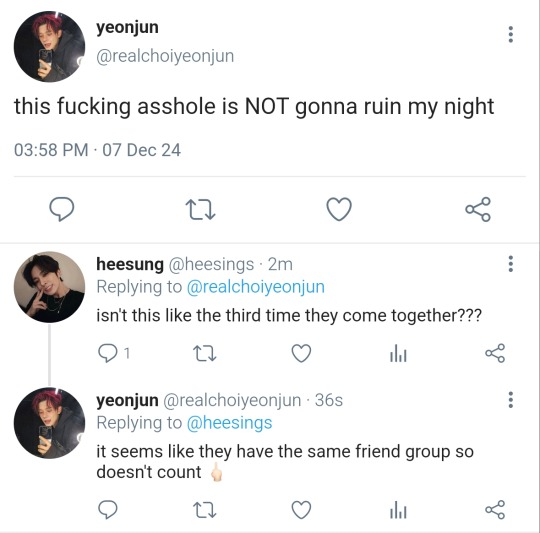
To absolutely no one's surprise, drunk Hyunjin is the biggest flirt ever. Even though you know he means nothing by it, you can't help but blush at every word that comes out of his pouty lips. He's fun to be around. Lucky for you, he also gets distracted with literally anything when he's drunk so he ends up following Felix around asking about the sparkly drink in his hand.
The idea of going home pops up in your head, but some guy's voice interrupts your scheming. "We finally meet."
You turn around and right there, where Hyunjin was seated just a few seconds ago, is the guy from the club. Well, he's also the guy from the festival. "Finally?"
"I've been looking for you for literally weeks," he says while laughing. "Oh, but not in a creepy way, of course. But I saw you like two weeks ago with Lee's group and I wanted to say hi, you know like introduce myself, and tell you you look pretty. I mean you are pretty, but you already know that. Oh my goodness, I'm rambling. Sorry, my friends say I'm a yapper."
You laugh. A real laugh. A laugh that makes you tear up and want to clap your hands. And he laughs with you. "What's your name, Mr Yapper?"
"Yeonjun," he answers with a smile that makes you feel nervous. As if something inside you knew this was a bad idea but he was just so endearing and charming and good looking. Your mind is spiraling right now.
"YN," you introduce yourself and smile at him once again.
Before he gets to say anything else, Minho grabs him by the arm and takes him away. Thinking about it, when he mentioned he saw you with Lee's group, you assumed he was talking about Felix, maybe he was a friend. After all, Minho doesn't seem to have many of those. You look at them and they seem to be talking about something or someone, but you don't care all that much so you stay there waiting for them to be done.
"What the fuck are you doing here?" Minho hisses as soon as they're far enough from you.
"Didn't know you own the place," Yeonjun finds himself saying the same thing Heesung told him the frost time he saw you with Minho.
"Stay away from her." Is the only thing Minho says before turning around ready to go back to you.
"Are you afraid of me returning the favor?"
Minho knows exactly what Yeonjun's talking about. "Why would I?" He chooses to say.
"So you really don't care?" Yeonjun keeps trying to get a reaction out of him.
"You like YN that much? Ask her out and see if I care," little does he know that he's giving Yeonjun exactly what he wants, "she's just Felix's friend. I wouldn't want her to get involved with you and dragging my friends with her. Other than that, I don't really care about who she chooses to fuck around with." He says and leaves without looking back.

Meanwhile, you walk back to the table where the guys seem to have gathered. You just want to say your goodbyes and head home. But you stop in your tracks as soon as you hear your name in their conversation.
"What about YN?" Asks Chan looking at Minho. They all seem worried, even Hyunjin.
"What about her?" Minho asks annoyed.
"Well, we thought you kinda like her-" Starts explaining Felix but he's interrupted by Minho's outburst.
"Stop with that! I don't thinks she's pretty or cute or whatever. I don't have a stupid crush. I don't like her. I can barely stand her." He rolls his eyes and walks away.
Fuck. This is exactly why you were anxious about possibly having a crush on Minho. He's an asshole. He's moody and rude and stupid... And you still have a crush on him.
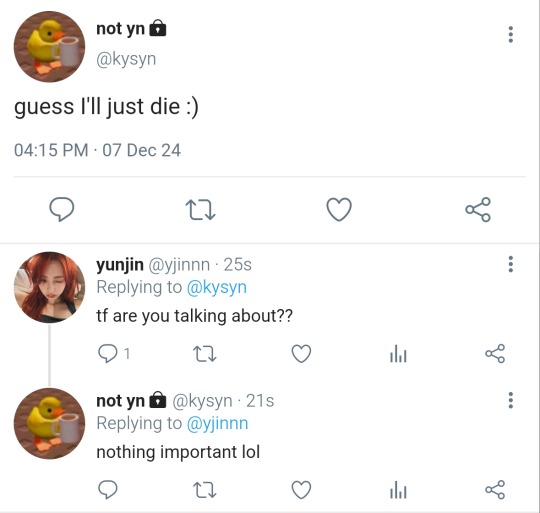
"Fuck it," you say and go straight to the bar and ask for a shot.
You feel upset. Not because he doesn't like you, but because he seems genuinely disgusted with the idea of it. You're not that bad, right? Sunghoon didn't feel like Minho, did he? And all of the negative thoughts and insecurities that have been plaguing your ming since you found out that Sunghoon was cheating on you resurface and makes you feel like shit.
You are about to ask for another shot but someone takes the little glass out of your hands.
"Easy there, you don't wanna get wasted so early, do you?"
"I thought you were with Minho," you say bitterly without looking at Yeonjun.
"Oh, fuck no." He says laughing, but there's something about that laugh. You can't exactly tell why, but now you're sure he despises Minho.
"Then stay with me for the night," you propose without thinking.
"You sure are straightforward," he laughs.
"Oh, my god, not like that!"
"Don't discard the idea like that," he jokes. "How about we have a drink and see where this goes?"
"Deal."
A voice in your head says that maybe you should've thought this through, but Minho is an asshole, Sunghoon cheated on you, your friends are nowhere to be seen, and Yeonjun is just so inviting. He looks like a good distraction, so you'll worry about the possible consequences tomorrow...

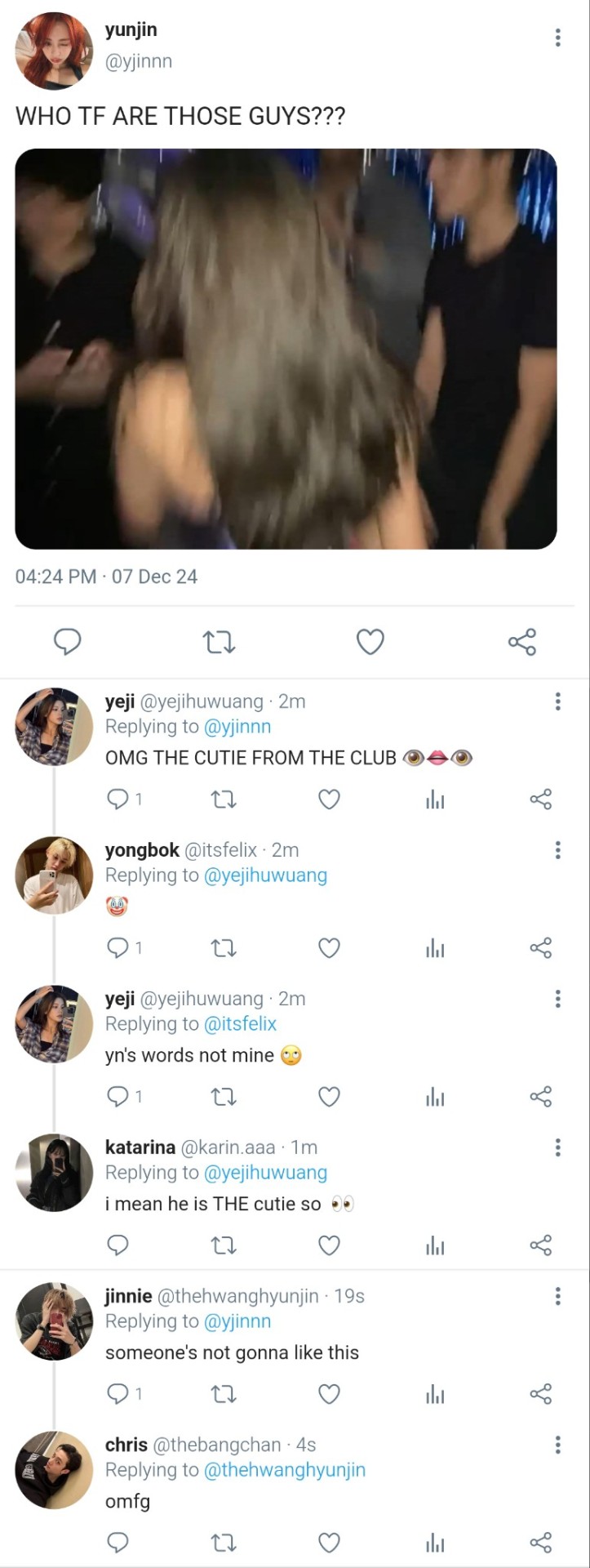

notes:
YN is definitely YNing rn
I'm sick and feel like dying but ngl I'm really excited for the next chapters so don't be surprised by the random updates
taglist: (39/50)
@estella-novella @poetryforthesad @lisaswifey @angelzforu @ihrtlix @gloriousqueenking @domfikeluva @circus-of-thoughts @conwunder @miniature-tragedy @jeonginplsholdmyhand
#kpop au#kpop smau#skz smau#txt smau#lee know imagines#lee know x reader#stray kids#tomorrow x together#yeonjun imagines#yeonjun x reader#social media au#kpop imagine#kpop scenarios#kpop fanfic#skz imagine#skz x reader#skz imagines#txt scenarios#txt imagine#txt imagines#txt x reader#le sserafim yunjin#aespa karina#itzy yeji#lee know smau#yeonjun smau#5targh0st#5targh0st number one girl
49 notes
·
View notes
Text
by Joseph Epstein
Since war broke out between Israel and Hamas, the anti-Israel trope of "settler-colonialism"—or foreign Jews displacing indigenous Palestinians has reemerged.
In the case of Israel, this term is no more accurate than such demonization of the Jewish state as an "apartheid" regime or saying that it is committing "genocide." The refutation of a Jewish connection to the land of their ancestors or the denial of a permanent Jewish presence in Israel stems either from ignorance or malevolence.
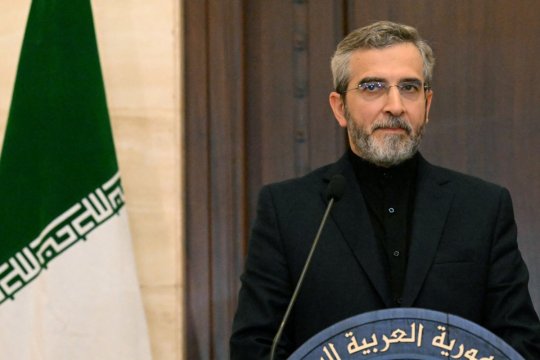
These countries have intentionally altered the demographics in war-torn Syria and Iraq to strengthen their geopolitical positions.
The worst offender is Iran, which has manipulated sectarian strife to form a Shia corridor from its borders to Lebanon to supply its main proxy, Hezbollah.
In Syria, Iran has settled Shia families from Iraq and Lebanon in strategic Sunni areas between Damascus and the Lebanese border. Tehran has found a partner in the Alawite Islamic sect, which dominates the Syrian regime. President Bashar Al-Assad and other members of the Alawite minority oppress the Sunni-majority that was largely behind the Arab Spring revolution in 2011. As a result, Syria has helped facilitate the export of Iran's Twelver Shia Islam—a branch practiced by the Iranian regime—to areas under Damascus's control. Assad has allowed Twelver foreign clerics to occupy senior religious positions and relaxed visa restrictions for Iranians and Iraqis, leading to an influx of Shiites.
A similar story has taken place in Iraq. Following the U.S. removal of Saddam Hussein, Iraq fell into religious sectarianism, allowing Iran to quickly become the patron of the much of the ruling Shia majority. Under the pretext of war against terrorism and the Islamic State, Tehran began systemically changing the demographics to solidify its corridor to Lebanon. Iranian-backed militias were at the forefront of sectarian cleansing of Sunnis in areas like Tel Afar, Mosul and Fallujah.
Iran often uses the pretext of Shia shrines to justify the presence of its militia proxies. Following battles in areas around the "Sunni Triangle" city Samara—home to the Al-Hadi and Al-Askari shrines—thousands of hectares of agricultural land owned by Sunnis was confiscated and its residents were not allowed to return to their homes. In Syria, protecting Shia shrines in the capital of Damascus and its suburbs gave Iranian proxies, including Hezbollah, an excuse to fortify its presence.
30 notes
·
View notes
Text
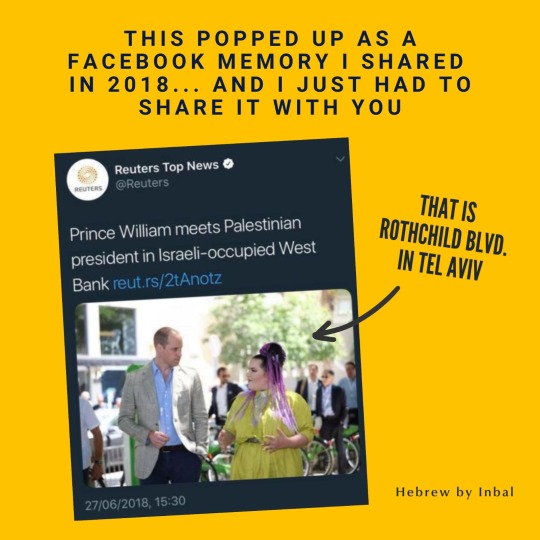
Okay, so picture this:
I’m sitting on a bench in Rothchild Blvd., sipping my coffee and watching this commotion from afar.
When I head home and see this news item pop up on my feed. I laughed so hard!
Now, fast forward to today, where reality is so twisted that watermelons are somehow an anti-Israeli symbol (what??), and Zionism represents evil and colonialism...
When this post I shared in 2018 resurfaced as a memory, I couldn’t help but think – even back then, it's either you laugh or you cry - when the story is that far from the truth!
In the picture is Israeli singer Netta Barzilai - who won the Eurovision - walking with the prince in Rotchild Blvd. in Tel Aviv.
18 notes
·
View notes
Text
Broken Promises of Compensation for Sinjaris

Sinjar has been the site of grave war crimes and mass displacement going back a decade, with about 183,000 Sinjaris still displaced today. Yet despite years of waiting, not a single person from Sinjar has received the compensation payments that they are entitled to under Iraqi law for destruction of and damage to their property, we found a year ago.
80 percent of public infrastructure and 70 percent of homes in Sinjar Town were destroyed during the conflict against ISIS between 2014 and 2017. Without this compensation, many displaced Sinjaris lack the financial means to go home and rebuild the homes and businesses lost during the war. A decade on, tens of thousands of Sinjaris are still living in camps across the Kurdistan Region of Iraq and largely reliant on humanitarian assistance. As the federal government’s July 30 deadline for closing these camps looms near, delivering these payments becomes even more important.
As of a year ago, 3,500 completed compensation claims were awaiting payment from the Ninewa Governorate’s Finance Department. That number has now risen to 10,000, and still not a single payment has been made, a representative of the Sinjar compensation office told Human Rights Watch.
The office has processed another 26,000 claims that are waiting for final approval from the appeals court before sending them to the Finance Department for payment, the representative said.
“We finished processing all the cases filed between 2021 and 2023, so there is no more backlog,” Judge Ammar Mohammed, head of the Tel Afar Compensation Committee, which oversees the Sinjar sub-office, told me. “We’ve done our job. It’s now the government’s job to pay.”
6 notes
·
View notes
Text
The world looks a lot different from Kibbutz Kfar Aza than it does in the United States or any other point on the planet. The difference is obvious in Tel Aviv, Jerusalem or anywhere else in Israel. Throughout the world in most mainstream media accounts and commentary from supposedly enlightened members of the chattering classes, the current war being fought in Gaza between Israel and Hamas is seen as merely the latest twist in a long cycle of violence between Israelis and Palestinians. From that perspective, it’s just more evidence of the cruelty of war to which the only possible moral response is to tell everyone involved to stop it, especially when the alleged underdogs—the Palestinians—are being defeated.
To those who look on from afar, the history of the conflict or the rights and wrongs of how the war started—even the unspeakable atrocities committed on Oct. 7 at Kfar Aza and 21 other Israeli communities when Palestinians associated with Hamas violated a ceasefire, crossed the border and murdered, raped, tortured and kidnapped people—are just details that act to incite the combatants.
Advertisement
But those details matter, especially if they involve the right to live in safety and relative peace.
A just war
This war is between a democratic nation fighting for its existence against an Islamist movement whose goal is the destruction of Israel and the Jewish people. Yet many outside of Israel, even those who do know the history and essential nature of the two sides in this struggle, such as President Joe Biden and U.S. Secretary of State Antony Blinken, are increasingly speaking as if the only thing to do is to end the war as soon as possible. They say the aftermath of the war must mean that Hamas survives—and gets away with mass murder. That means the Palestinians are rewarded for such abominations with an independent state that will likely have the ability to pursue the terrorist organization’s goal for many more days like Oct. 7. Somehow, that makes sense in Washington and other places.
But not in Israel.
The overwhelming majority of Israelis, including many, if not most, of those who oppose Prime Minister Benjamin Netanyahu, see it very differently. And to understand why, maybe you need to go to Kfar Aza and see the ruins and makeshift memorials to the people who lived in that small kibbutz near the Gaza border who were brutally murdered, raped or kidnapped by Palestinians.
If so, you’ll soon realize that the battle with Hamas isn’t one about Israelis ruthlessly harming Palestinians. Nor is it about “white” oppressors seeking to dominate powerless “people of color,” as many left-wing Americans think. Nor is it one in which tired diplomatic theories about a “two-state solution,” which have repeatedly been rejected by the Palestinian people, can be employed to get a messy situation under control, not to mention ease some of Biden’s political problems.
To be in Israel during this war is to experience both the strength and the fragility of the Jewish state. Yet the general public wouldn’t necessarily think that if all they know of the Middle East is what’s seen on news shows. After all, life goes on pretty much as normal, even if some businesses and farming areas in southern and northern Israel have clearly suffered due to the absence of employees because so many people have been called into active military service. The buses and trains are running, and people still go to the movies and concerts, as well as other normal activities.
The hotels are also full, but not with tourists. That is a key giveaway that something isn’t right. Walk into many hotels in Jerusalem or Tel Aviv, and something is a little off. They’re packed with people but not tourists on vacation from abroad. Chat with even a few of the hundreds of thousands of Israelis—families with small children and elderly people prominent among them—who were forced to flee their homes in the south near Gaza and the north near Lebanon, and you get a view of the war that is omitted in the breathless coverage of Palestinian suffering.
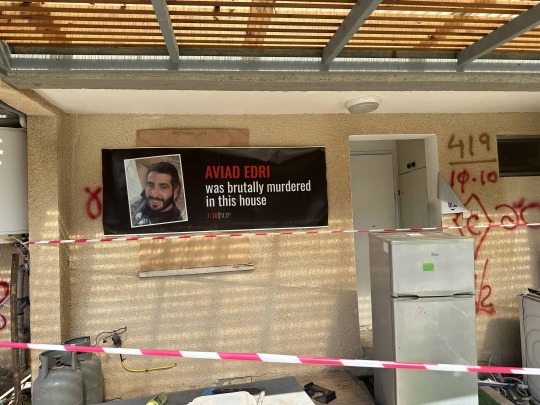
A country united by grief and determination
To understand what’s going on, you need to talk to Israelis who have been called back into the military and willingly risking their lives fighting in Gaza. Though they’re eager to resume their regular lives, many I spoke with are just as ready to return to the battlefield because they know the job of destroying a deadly threat to their country isn’t finished. While international opinion deplores the possibility that Israel will attack the city of Rafah—Hamas’s last major enclave inside Gaza—few Israelis I spoke to, including those who have served, are prepared to halt the war until all of the perpetrators of the Oct. 7 massacres are stripped of the ability to repeat their crimes.
You don’t have to do a lot of reporting before you realize that morale among Israeli soldiers is high and stretches across all the cultural, political and religious debates that divide Israeli society. It’s not because they relish war or bloodshed. They don’t want to kill Palestinians and also grieve the loss of so many of their comrades—casualties made more likely because of the strict rules of engagement that prevent the Israel Defense Forces from fully utilizing the firepower at their disposal to lower the number of civilians killed because Hamas uses them as human shields.
Their spirit remains strong. They know that what they are doing has nothing to do with the lies about “apartheid,” “settler-colonialism,” “occupation” or “genocide” that are thrown about at antisemitic demonstrations in U.S. cities or on college campuses and are treated as acceptable discourse in mainstream publications like The New York Times.
Israeli soldiers—young conscripts and veteran reservists alike—aren’t down about the war because they know that what they are doing is defending their homes and families. It’s the civic faith in the justice of their cause that resonates throughout Israeli society and pervades the thinking of those who have sent their loved ones to battle. It is also felt by the grieving families of those who didn’t come home. Israel is a nation that is united by both anguish and determination.
Americans understand war differently
This may come as a shock to Americans, who are used to thinking of wars in a very different way.
Since World War II, Americans were sent to fight dismal and bloody proxy wars in Korea and Vietnam, where the rhetoric about defending democracy against communism rang hollow for many. That was just as true about the attitudes toward the wars fought in Afghanistan and Iraq in this century. Despite any initial enthusiasm about punishing the perpetrators of 9/11 or toppling dictator Saddam Hussein, those conflicts turned into messy quagmires that most Americans—whether on the right or the left—wished to escape. Though the opponents of the United States were clearly evil, by the time both wars ended in what history will record as defeats, they hardly seemed worth the sacrifice of blood and treasure that had been expended on them. Even before the final rout of Americans during the Biden administration’s disastrous withdrawal from Afghanistan, these wars had already been sealed in the country’s collective memory by both popular culture and the opinion of most serious commentators as terrible mistakes.
Coverage of Israel’s war against Hamas makes it seem as if it is another version of hapless and brutal Westerners fighting Muslims in futile efforts that cannot succeed, similar to the way Americans failed in Iraq and Afghanistan. But the overwhelming majority of Israelis—from secular left-wing Tel Avivians to pious Jerusalemites and all points in between—know their war is different.
They understand that their opponents are not in far-off lands like America’s in recent decades, and their raw violence directly threatens them. Though Israel has prospered in the 75 years since the Jews regained sovereignty in their ancient homeland, it hasn’t known a day of complete peace. Palestinian Arabs, their foreign allies and enablers in the Muslim and Arab world, as well as those in the West and international community, have never given up their quest to destroy the one Jewish state on the planet.
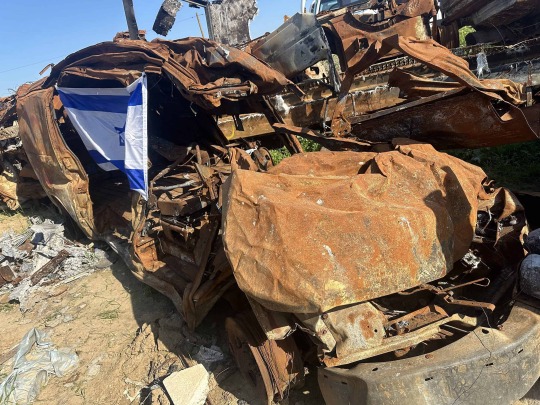
Places of pilgrimage
That’s why the view from Kfar Aza, and other Israeli kibbutzim and towns throughout southern Israel, is so different.
The sites of the massacres have become places of pilgrimage for Israelis and visitors to the country—and rightly so. To see the homes in places like Kfar Aza that were riddled with bullets and/or burned by the terrorists, and to learn of the horrible fates of their inhabitants, is a searing experience. The same is true for the fields where the Nova music festival took place, and where hundreds of young people were slaughtered, raped and kidnapped—and which are now filled with makeshift memorials to the victims and those taken hostage. Just as haunting are the nearby fields where the wreckage of hundreds of burned-out cars of festival attendees have been piled up and for the time being, left as a gruesome reminder of their fate.
After a brief period of interest and empathy, most of the international media lost interest in the story of Oct. 7. Americans don’t hear from those who survived the attacks or those who risked their lives to rescue some of the victims. But their stories do resonate with fellow Israelis, who understand that they could have just as easily found themselves the prey of Hamas murderers hunting for Jews to torment and kill on that terrible day.
The fate of the hostages also hangs over the country. The pain of the families of those who are still held in captivity by Hamas is felt by everyone there. And while politics has intruded into the discussion—as the anti-judicial reform movement that paralyzed the country has taken control of the weekly “hostage square” protests in Tel Aviv and focused their animus at Israeli Prime Minister Benjamin Netanyahu rather than Hamas—support for the war effort remains largely unshaken.
The notion of stopping the fighting to allow Hamas to survive while still armed and in control of part of Gaza is widely considered reasonable elsewhere, but not in Israel. There, they understand that if Hamas is allowed to fully escape the consequences of the war it started, it will only mean that it will be allowed to make good on its promise to repeat the Oct. 7 atrocities again and again.
The widespread assumption in America—even among major Jewish organizations that are supposed to have Israel and the Jewish people’s best interests at heart—that a Palestinian state must be created after the war ends is opposed even by most on the Israeli left. They know that rewarding Hamas and its supporters with such a gesture isn’t just an invitation to more bloodshed. It’s also immoral and will ensure that the conflict never ends. The independent Palestinian state in all but name ruled by Hamas in Gaza before Oct. 7 was evidence of what such a “solution” would mean for Israel. They understand that a state in Gaza, as well as one in Judea and Samaria, controlled by genocidal terrorists and their morally equivalent political rivals—the Palestinian Authority and the Fatah Party—could place the entire country in danger.
But that’s hard to see in Washington, even by those not motivated by leftist ideologies to hate Israel and to cheer the slaughter of Jews. Still, it’s a truth that is difficult to escape when looking at the ruins of Kfar Aza.
9 notes
·
View notes
Text
Gunpla: Completed Collection of Minis: Part 4: Gundam SEED

Next is the SEED Figures. These guys will have a lot of cockpit shots because i already finished off most of their models (though a couple of them were back before i was doing water slides, and just using the decal-stickers and dry-rubs that came with most non-ver-ka MGs)
PG Astray Red Frame: Lowe Gule
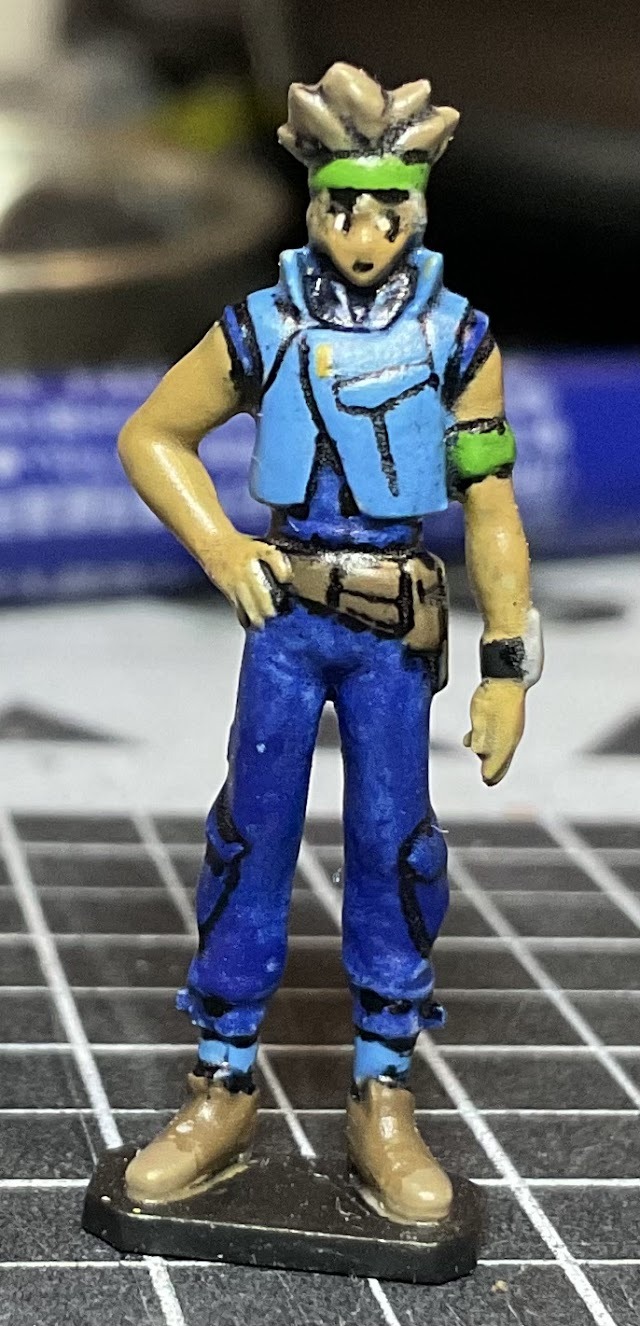
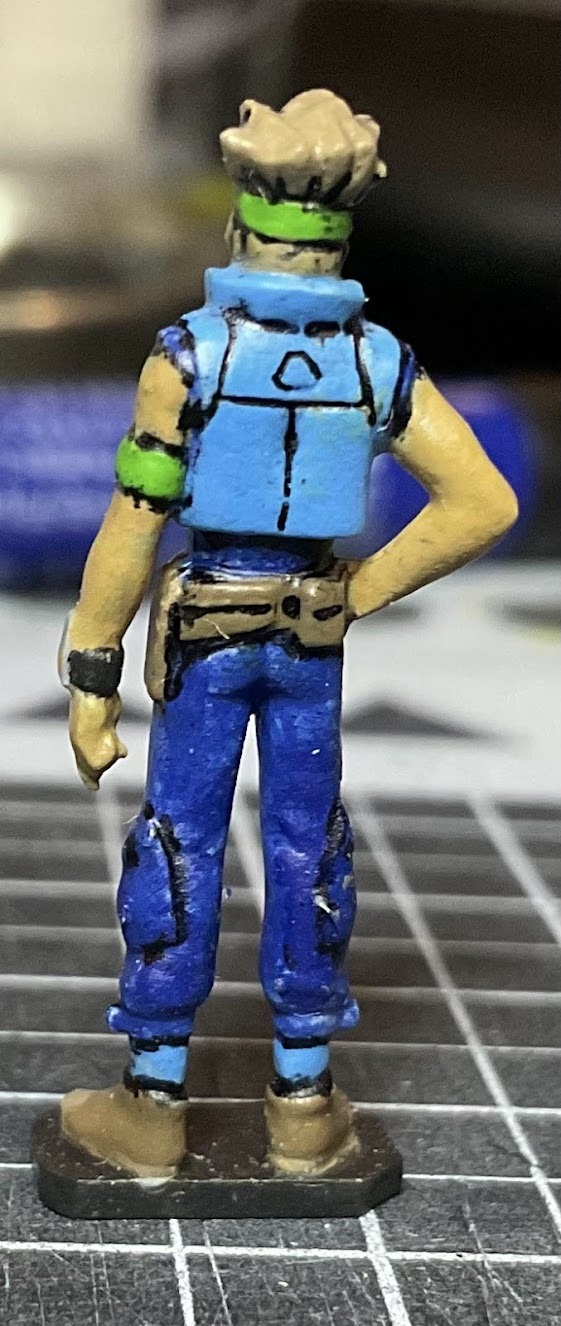
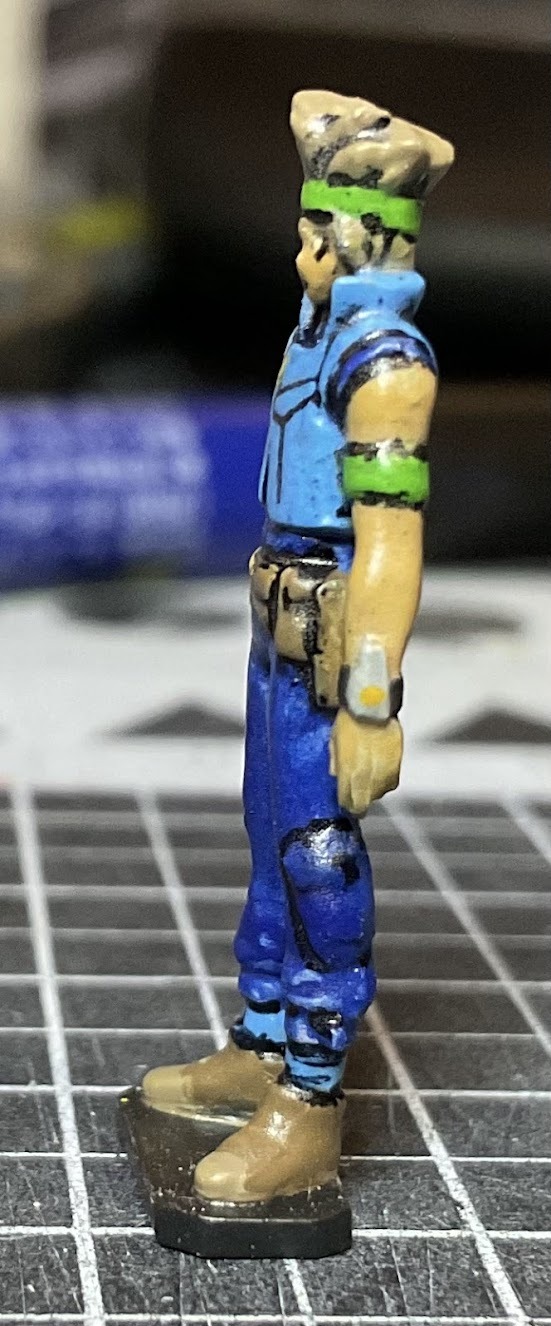
This was done before i had access to my magnifying binoculars. The panel lining was actually done with gundam panel line marker, over Mr. Super Clear Gloss. This kinda turned out well. However, his "brother" (the pilot figurine) wasn't so lucky: (under the cut)
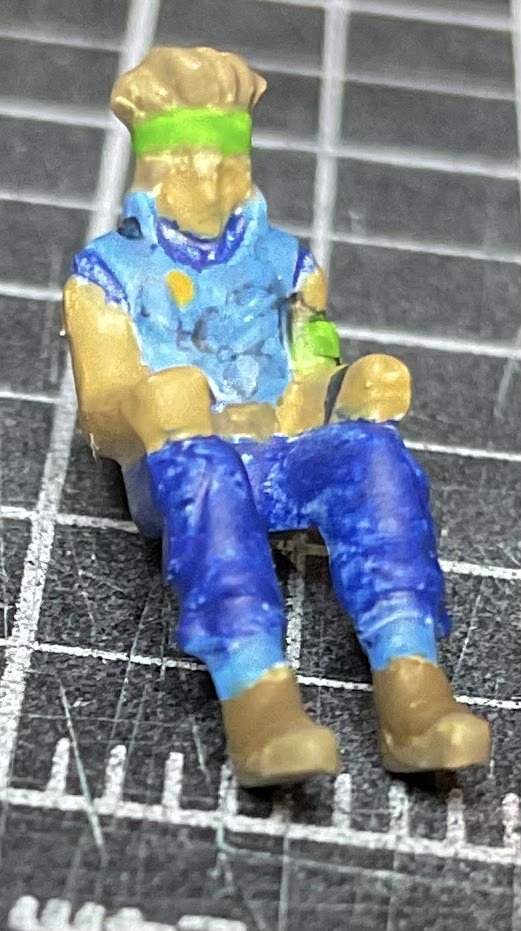
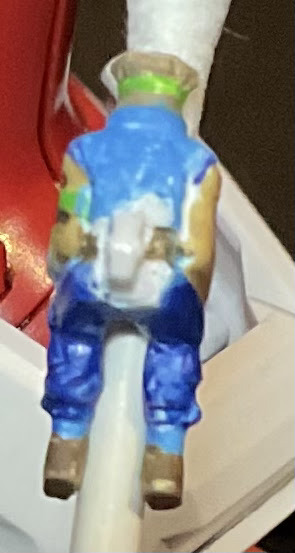
This one i started panel lining, then messed up and erased, and it wound up not coming off right. So i just didn't bother and went ahead and finished it with a flat coat, no nuln oil for detailing or anything. BTW, the way i captured that backshot gives me an idea for what i could do with suit-less pilots.... but i'll leave that for another day. Anyway, i actually already water slide decaled his suit, so i could take pictures of him in the cockpit!
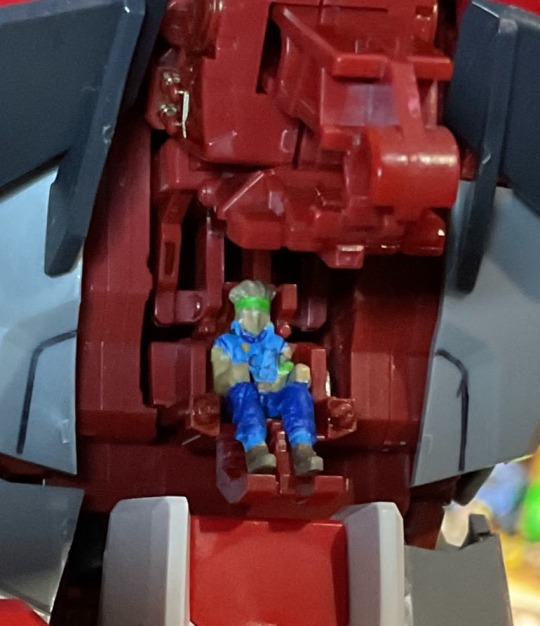
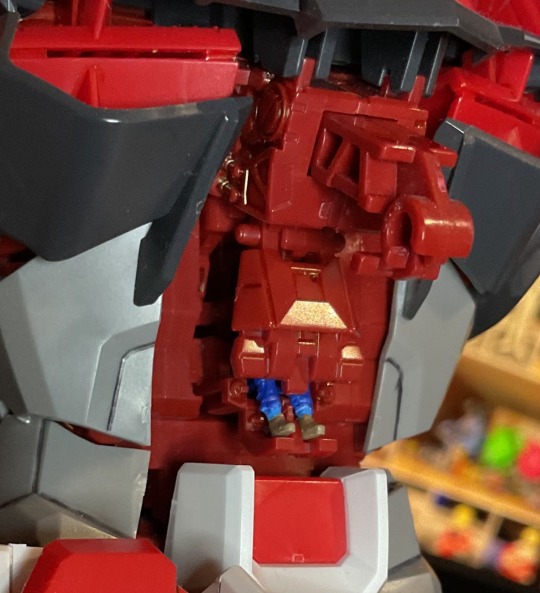
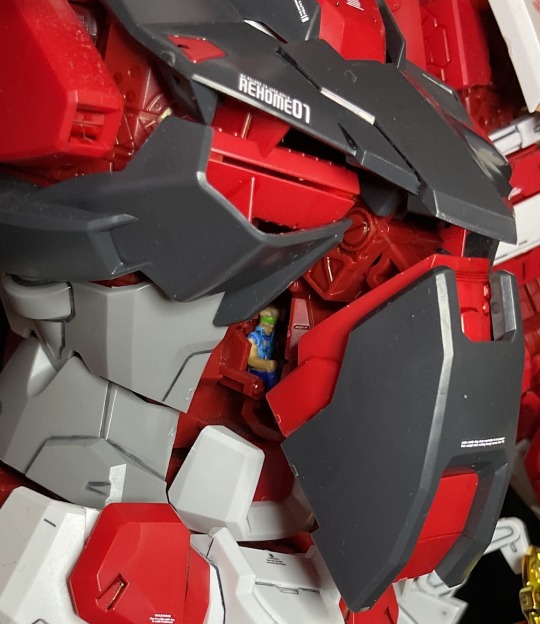
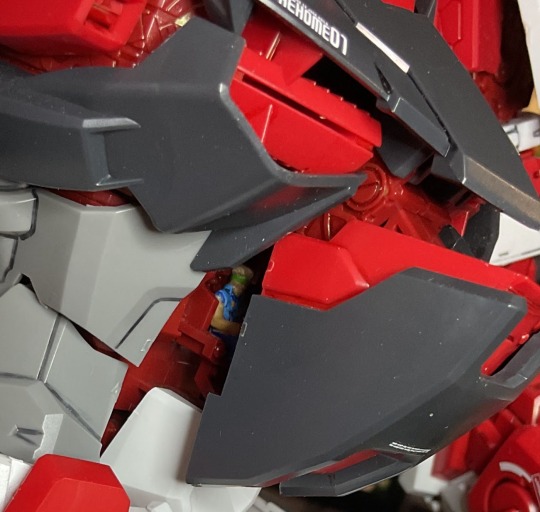
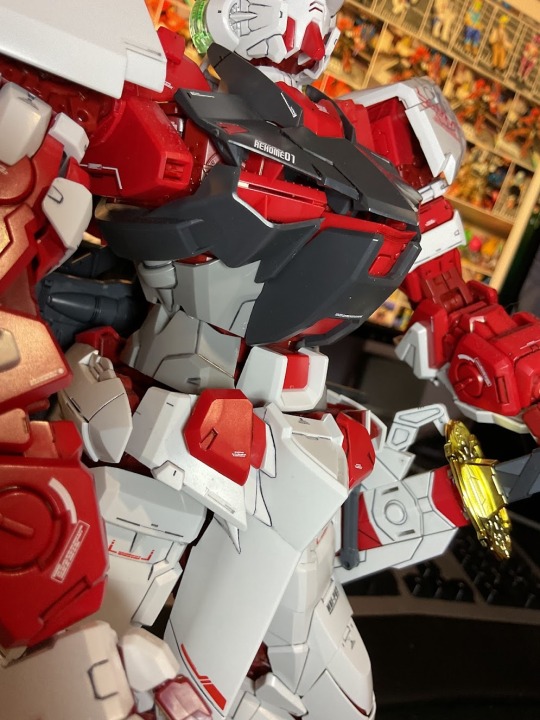

Oops, got a little carried away there.
moving on...
MG Strike Rouge + Ootori: Cagalli Yula Athha

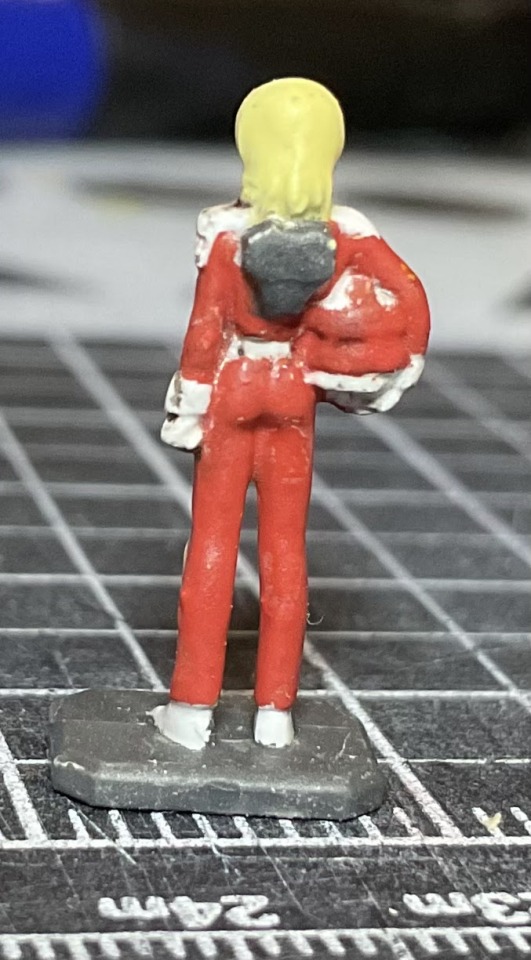
This was THE first figure i tried nuln oil on. However, it turned out kinda messy, because it was a tutorial my friend was showing me. HOWEVER HOWEVER, i managed to recover it without too much work! I think she looks decent overall.
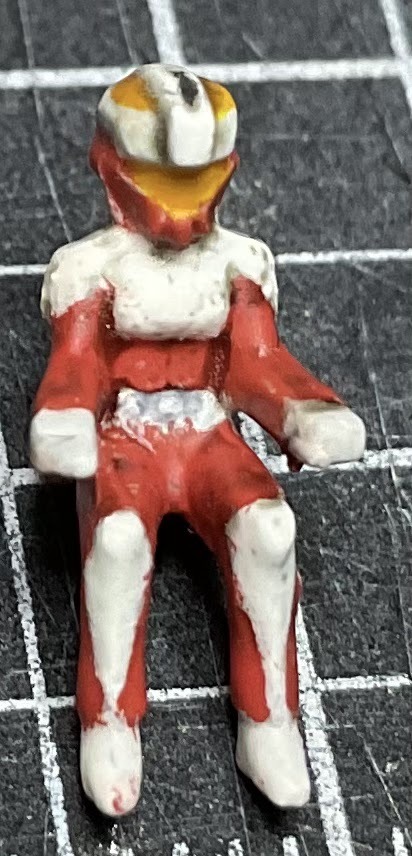
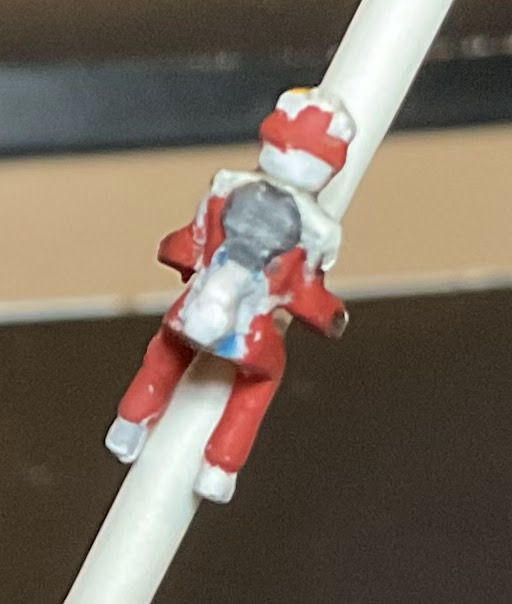
The pilot figurine was also finished with Nuln Oil, but after i knew what i was doing. I think she turned out a bit better.
Next, we're gonna go behind the scenes and see some of the movie magic i use to make it seem like these guys are in fully constructed models (I already tricked you with the post about the Hi-nu!)
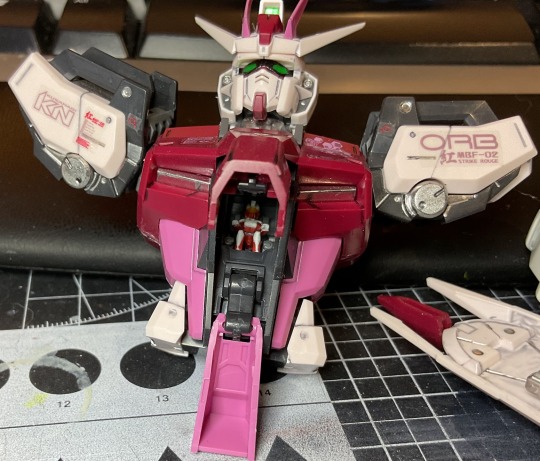
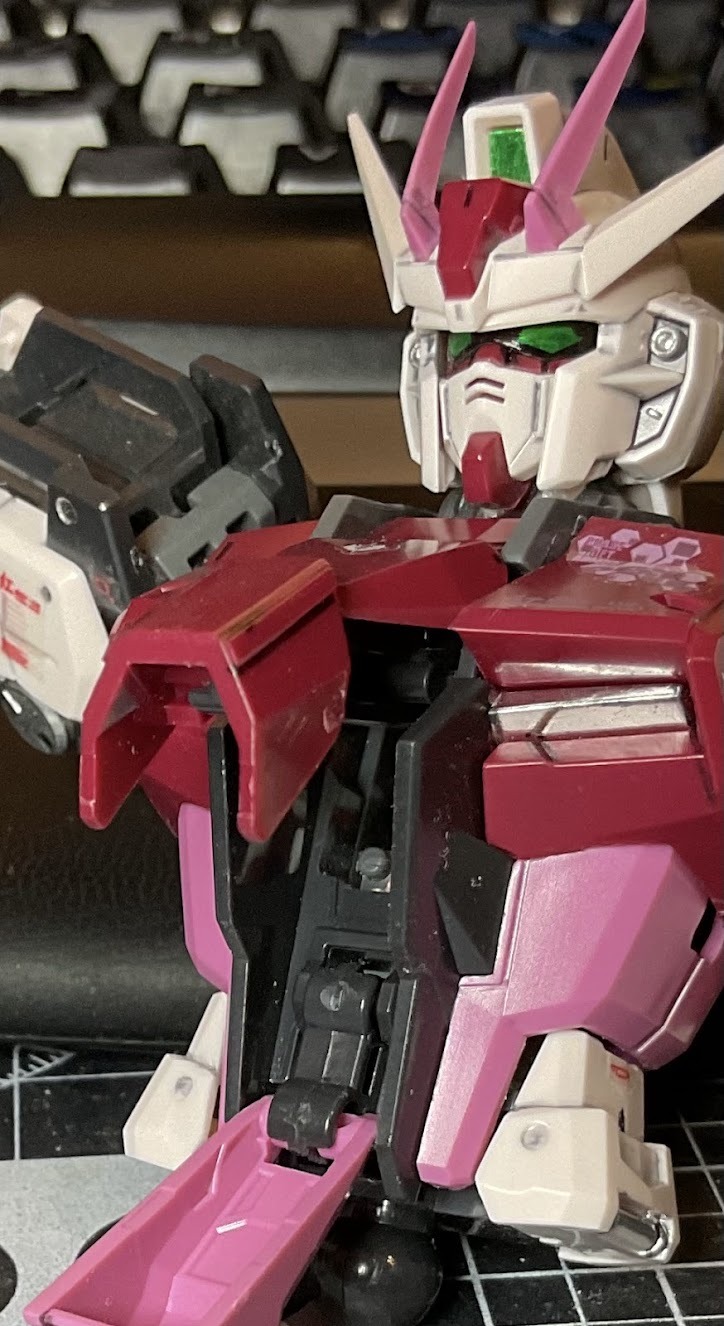
Some basic shots showing the cockpit hatch structure.
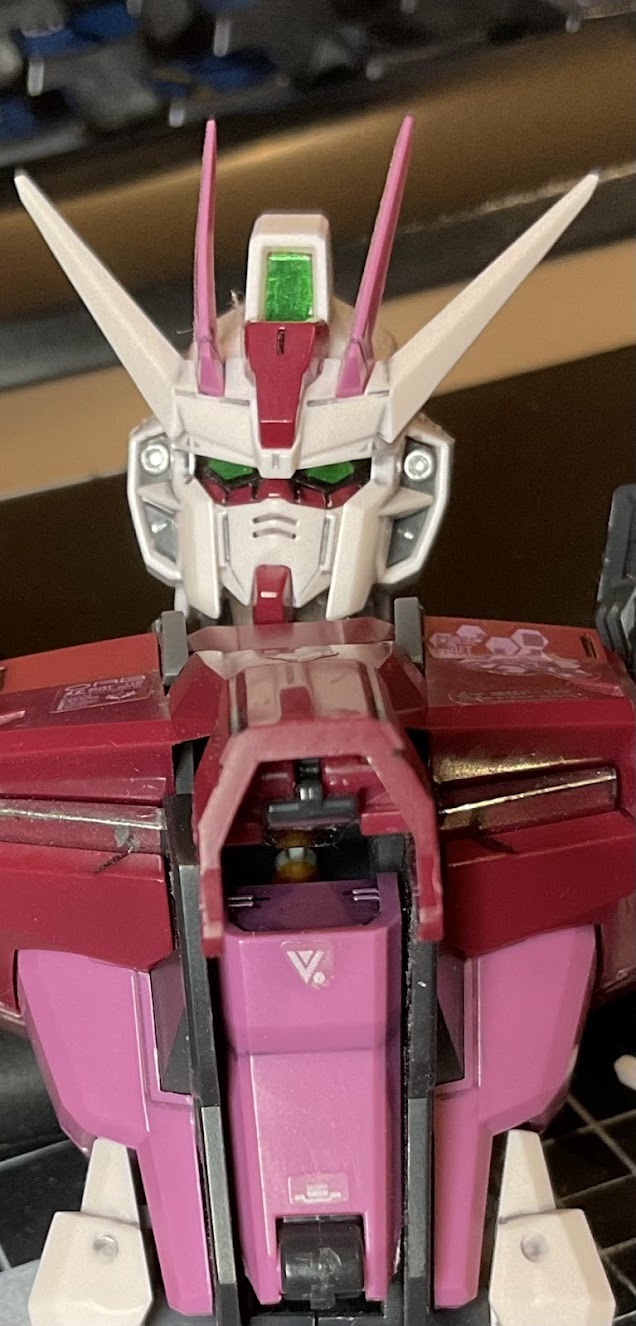

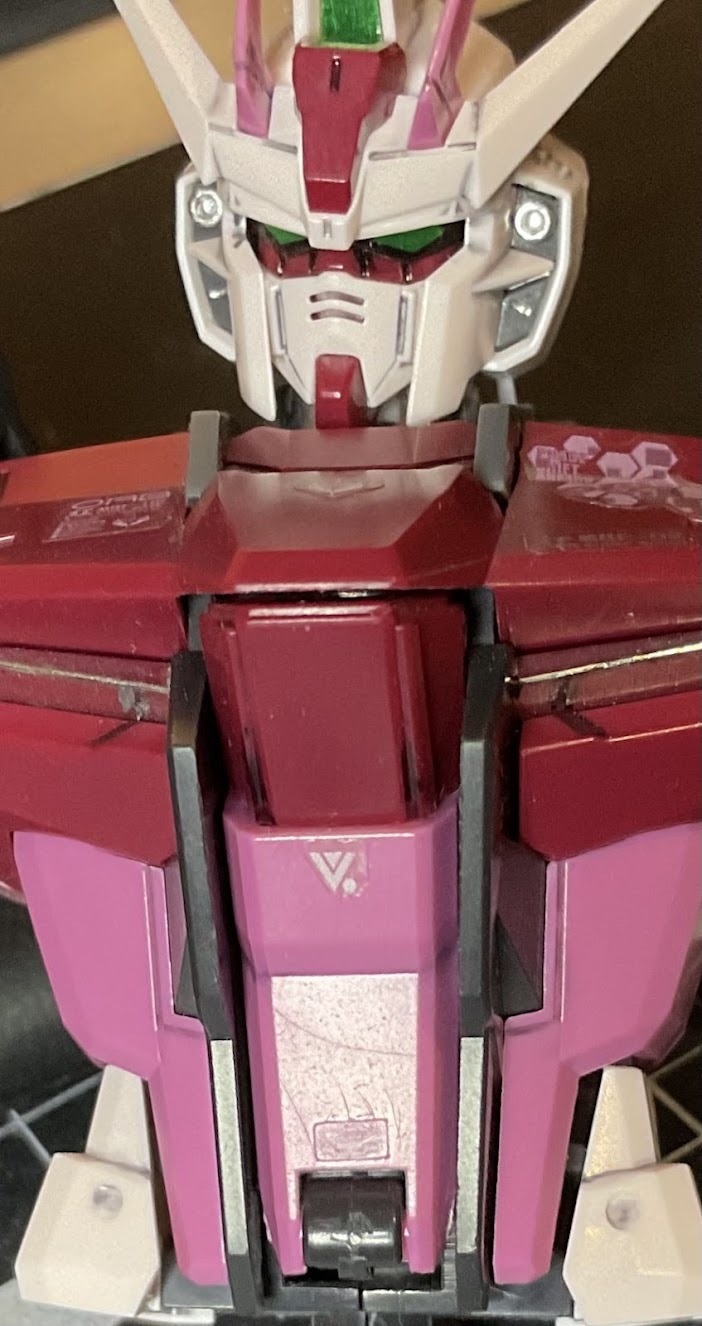
And now you can't tell again that it's not complete!
The hatch is now closed. We move onto another pink gundam:
MG Infinite Justice: Athrun Zala
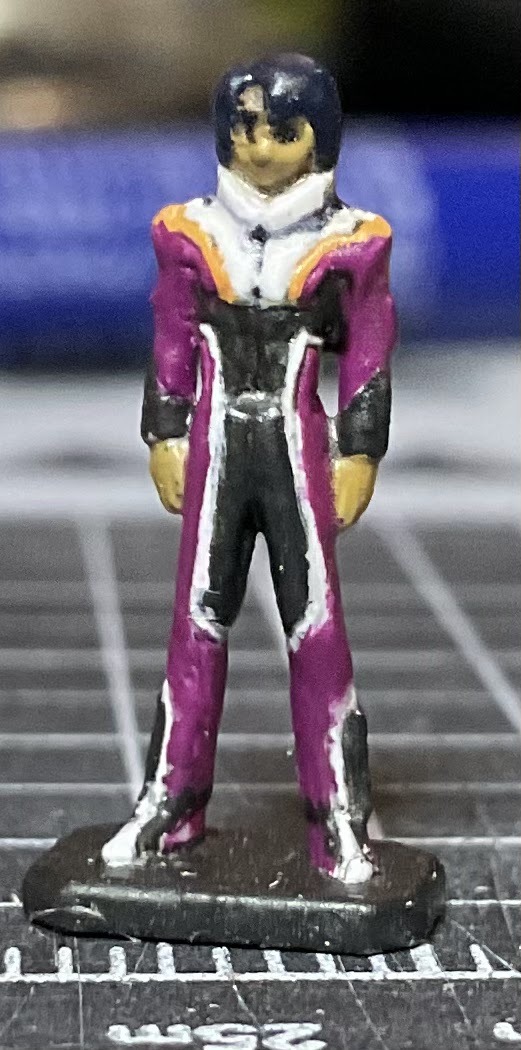
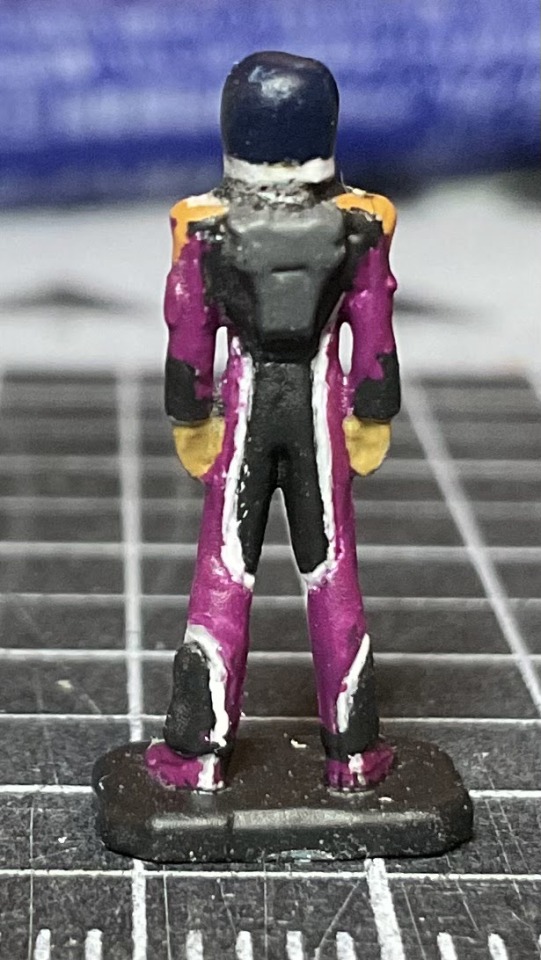
I finished him with only a little bit of panel liner, down the middle of his chest, and nuln oil on the face. A little blobby/messy but still achieves a decent effect from afar.
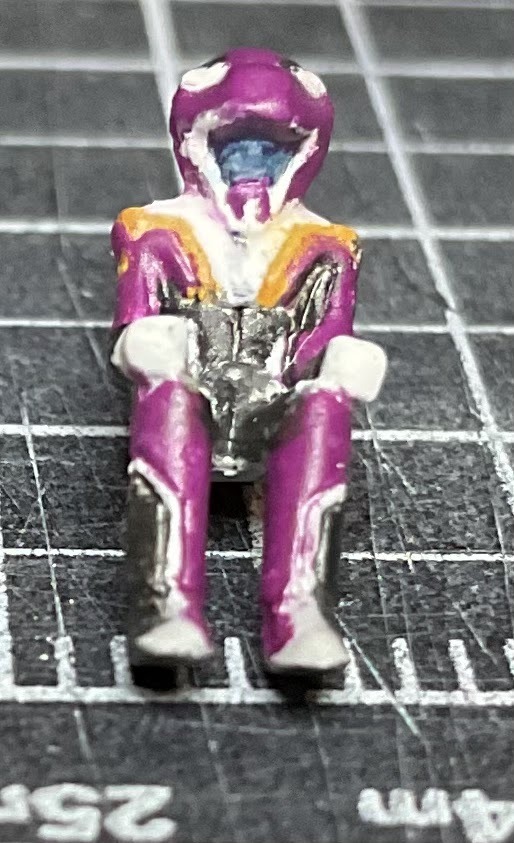
Here's the pilot figurine. No backshot because i pretty much left his back unfinished. You have to constantly change the thing holding the figure in order to paint certain sections and i was getting tired of trying to do the back.
His cockpit operates very simply, so i only have a few shots:
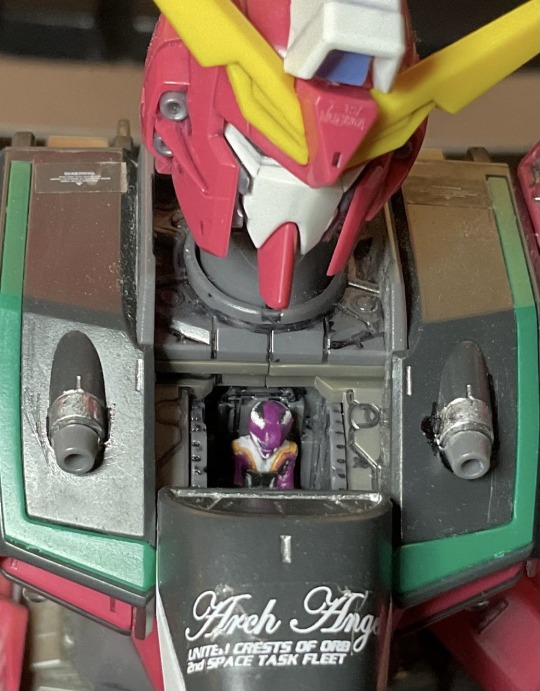
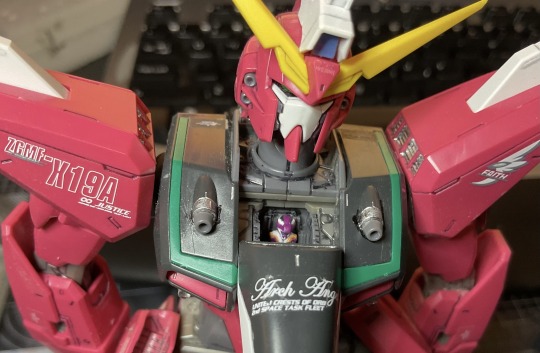
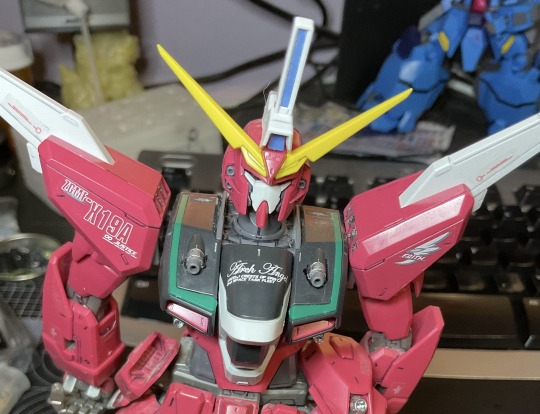
Yup, there he is. He's actually mostly fully built because i had to detach him from the sick ass plane he normally hangs from. Yes, the mecha suit i mean hangs from a plane. It's so sick, i'll have pictures in another post dedicates to this kit.
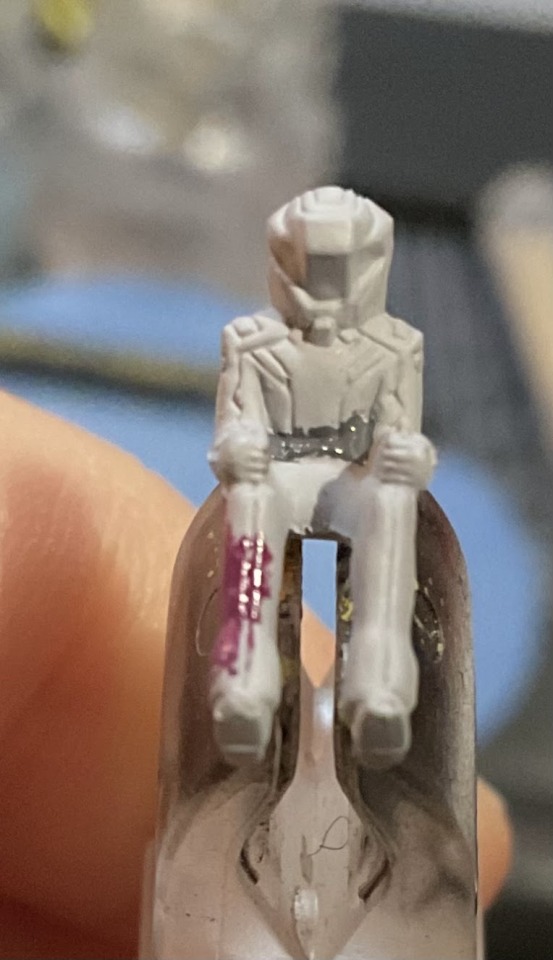
BONUS: So, for a while, i had this figurine that i THOUGHT was the pilot figurine for this kit. But then one day i opened up the cockpit hatch and saw the figurine. So who is this guy? what kit does he come from? I'm not even sure if it comes from a PG (1/60) or an MG (1/100), it seems closer in size to the PGs though. You can see i attempted to start painting it in Athrun Zala colors. I actually finished it but it looked so weird trying to force the sculpt to match the image. My friend thinks the sculpt looks like it could be a specific pilot outfit that Kira Yamato wears. It's equally likely it might be a Mu from a PG Sky Grasper. Can anyone positively identify the kit this figurine comes from? The few possibilities we think it might be are kits my friend used to have, but lost due to Moving Shenanigans. so we cannot confirm that those kits are missing pilots. ANyway, moving on, to the final figures:
2x RG Strike Freedom: Kira Yamato

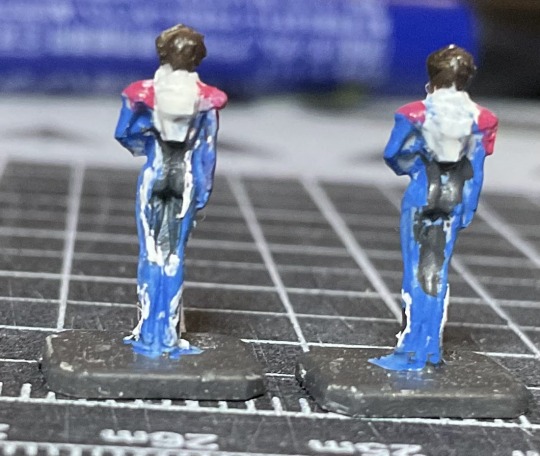
Why do i have two of these guys? Because i have two of the kits! The Strike Freedom was the first RG I assembled, in 2020. In 2021, i got P-Bandai's "Titanium Finish" release of the exact same kit. Thus, i had two Kira Yamatos to paint. These both were painted in my first run of minis in Fall 2023, and they are the last of such minis to be shown off here! I did not panel line them, hell you can tell that getting the stripes on their tiny pilot suits was hard enough. They're very messy and have bad color separation. Honestly, i might try redoing one of them now that i have magnifying goggles. It would be worth it. And as a reminder, since these came with an RG, they are 1/144 scale, so a bit tinier than most of the others i've shown off (which are 1/60 or 1/100).
I believe that does it for Part 4. I just barely had enough image slots for all these pictures, but sadly not enough for some "gags" i wanted to do. there would have been 3 more images in the set of 6 pictures of Lowe Gule boarding the Astray Red Frame, but i had to cut them for extra space. To read part 5, Click This Link!
#gundam#gunpla#plamo#bandai#gundam seed#kira yamato#cagalli yula athha#athrun zala#lowe gule#astray red frame#infinite justice#strike rouge#MG#master grade#RG#Real grade#PG#perfect grade#mini painting
3 notes
·
View notes
Text

11 Sivan - Bnei Brak - 1924
On this day in 1924, the town of B’nai Brak was settled just east of Tel Aviv in Israel. The town is originally mentioned in the Book of Yehoshua and is most famous for being the place of the all-night Seder mentioned in the Passover Haggadah that was led by R’ Akiva. During the 4th Aliyah, 8 Chassidic families immigrated from Poland intending to build a religious agricultural settlement. By 1933, those 8 families had attracted over 1,000 others including the Chazon Ish who was considered the leading Rabbi in Israel until he died in 1953. The Jewish world was being guided from his little house in the town. By 1948, the population would be almost 10,000, and today there are nearly 200,000 residents. In 1950, B’nai Brak became an official city of the young State of Israel.
Much of the growth and development of B’nai Brak can be attributed to R’ Yosef Shlomo Kahaneman. R’ Kahaneman had already led the city of Ponevezh in Lithuania for 20 years. One of the largest Jewish cities in Lithuania, under his tutelage the city exploded as a center of Torah. At the outbreak of WWII, he was on a trip to Israel and found himself stranded there. He continued to run the city’s institutions from afar. In 1941, the city of Ponevezh was decimated first by the Red Army and then a few days later by the Nazis y”s. The local Yeshiva was destroyed and all its students were murdered. What was R’ Kahaneman’s response? Within two years he opened the Ponevezh Yeshiva in Bnei Brak with Rommel and the Nazis just a few sand dunes away in North Africa. As Europe was up in smoke, he saw his duty to rebuild Torah in Israel. Within a few months, Rommel would be dead and the Ponevezh Yeshiva would be on its way to making R’ Kahaneman’s vision a reality.
Rabbi Pinchas L. Landis
13 notes
·
View notes
Note
What do you think of the protests in Tel Aviv right now? Have you been able to go? Anyway, supporting the Israeli people from afar! Hoping to make aliyah soon so I can join everyone 🙂
They’re great! The conversation has morphed from one strictly about government overreach into some talking points I don’t completely agree with but to each their own. Overall it’s been a wonderful thing to see. But no, I haven’t made it out yet. Crisis typically means the ED is flooded so that’s where I’ve been. I’m trying to get out at some point, I just haven’t been able to make it work.
Mazel and brachos on the possible aliyah! We’d love to have you 💙
7 notes
·
View notes
Text
Last Sunday in New York, thousands marched in the annual pro-Israel parade, less a celebration this year than a rally for the hostages held by Hamas since October 7. The parade’s sponsor, New York’s Jewish Community Relations Council, said its goal was “sending an urgent message to the world: ‘Bring Them Home Now!’” — raising awareness of the plight of the captives, without calling for specific actions to free them. By contrast, the day before, tens of thousands of protesters in Tel Aviv called on the government to strike a deal with Hamas for a ceasefire in the eight-month war in exchange for the return of the 120 remaining hostages, living and dead.
[...]
The two rallies and their competing messages demonstrate a divide between many American Jews and Israelis, both marching under the banner of “Free the hostages.” In Israel, many advocates for the hostages have been vocal in criticizing their government and calling for a ceasefire; in the United States, Jewish groups and individuals have been invoking the hostages either in apolitical gestures of solidarity, or to defend the aims of the war.
[...]
But while their messaging regularly focuses on Hamas atrocities and its violations of international law, the forum and its members have also been pointed in their domestic politics. In December, 80 days after the Hamas attacks, Nisan Calderon, brother of hostage Ofer Calderon, spoke at a rally organized by the forum. “I call on members of the cabinet and the government to work for the return of all hostages now,” he said. In March, 150 days after the attack, he spoke at a Health Committee meeting at the Knesset, complaining that no one from the Israeli government had contacted him — a common complaint among hostage families.
Historically, American Jews have been uncomfortable publicly criticizing the Israeli government from afar. At the same time, many are now facing their own insecurity in the wake of the war and rising anti-Israel and antisemitic activism.
[...]
As the war ground on and Israel faced more criticism both at home and abroad, symbols like the dog tags took on new meanings. “They had a quality of ‘I am with Israel no matter what. I will not criticize Israel,’” said [Rabbi Vanessa Ochs, emeritus professor of religious studies at the University of Virginia], who is a scholar of new rituals and Jewish material culture. “And for people who are critical of Israel it became a symbol of abdicating your role and responsibility for thinking about the consequences of what Israel is doing right now militarily.”
[...]
Amanda Berman, executive director of the “unapologetically Zionist” Zioness Movement, understands that to many Israeli activists, freeing the hostages means supporting a ceasefire. But by wearing a dog tag (next to a chai and other Jewish symbols), she’s expressing a different view of what it means to be “political.” “As an American Jew and as a human being of conscience, I want the war to end. But the question since the afternoon of October 7 has been, what has to happen in order for the war to end? And for me, that pressure should have been on Hamas to release the hostages and to stop shooting rockets and missiles into Israeli population centers and to stop threatening the sovereignty of the Jewish state,” she said. “And the minute that happens, the war will be over.” Berman’s may not be a pro-war message, but it focuses responsibility on Hamas instead of the Netanyahu government. And it was similar to a message conveyed by a delegation from Kibbutz Be’eri, a southern Israeli community hard hit during the Hamas attacks, that marched in New York’s Israel parade. Or Gat, whose sister Carmel is a hostage and whose mother Kinneret Gat was murdered that day, told JTA that the goal of their 10-day trip to the US was to raise awareness of the hostages and to speak about Hamas, “a terror organization that’s controlling Gaza and is the one that most hurts the Palestinian people.”
[...]
The We Are All Hostages movement wants more from American Jews, and said in their letter that they are available to speak to Jewish groups to press their case. “Your voices are crucial to saving our family members. Your voices can help end this war. Lives hang in the balance,” they wrote. “Our families hang in the balance. We need you with us.” Jill Jacobs of T’ruah said her group had come to a similar conclusion earlier in the war. On May 8, it issued a statement urging the Netanyahu government “to make a hostage and cease-fire deal and bring the hostages home.” She is aware, however, that even as the pro-Israel right abhors such implicit criticism of Israel, the pro-Palestinian left resists empathy for the hostages — and that the “kidnapped” posters were often torn down or covered. “There’s this idea [on the left] that it’s somehow a contradiction between calling for a ceasefire and saying anything about the hostages,” she said. “I wish that people on the far left in the US understood that a ceasefire and bringing home the hostages are actually the same things. They’re not different sides.”
0 notes
Text
For I will take you out of the nations; I will gather you from all the countries and bring you back to your own land." (Ezekiel 36:24) Today is Yom Ha'Atzmaut James, in Jerusalem, Tel Aviv, the Galilee and the Biblical Settlements, Israelis are celebrating Israel's 75th Birthday today.
They woke up this morning to a day filled with festivities that have been taking place throughout the country. Since sunset last night, this day has been filled with concerts, street parties, barbecues, festive prayers at the Western Wall, and lots of flag waving throughout the country. On this day, 75 years ago, Israel miraculously became an independent nation in fulfillment of many Bible prophecies. "Do not be afraid for I am with you: I will bring your children from the east and gather you from the west. I will say to the north, 'Give them up!' and to the south, 'Do not hold them back.' Bring my sons from afar and my daughters from the ends of the earth." Isaiah 43:6
0 notes
Text
Why choose the smart lighting system for your home and when?
Smart lighting system for home refers to the ability to control your lights from afar via a wireless connection and a smartphone app. Set timers for your lights, and make schedules or routines to turn them on and off at specific times or in response to specific actions. You can time your lights to sunrise and sunset, dim or alter their hue, control groups of lights on multiple circuits at the same time, and have lights automatically switch on and off in response to motion and/or occupancy.
You can also use voice commands or programmable wireless buttons and remotes to operate the lights.
Changing the hue of your lights to match the colour of the sun can help you feel more energised.
Here are just a few of the many applications for a smart lighting system for home:
Security and safety — Never return home to a dark house again; programme lights to switch on at random while you're gone to deter intruders. Without any cabling, use motion sensors to activate outdoor lights at night. You can also check smart home tech trends as well.
Convenience — If you frequently fall unconscious with the bedside light turned on, it can be set to turn off automatically. A simple command or schedule can turn everything off at night and then back on again in the morning. When you walk into a room, motion sensors switch on the lights and turn them off when you leave.
Health and well-being — A gentle rising light is less jarring than an alarm and actually works. Syncing your smart lighting system for your home to the hue of the sun throughout the day has been shown to help you feel more energised when needed and begin to wind down when needed. Color-changing bulbs are not only entertaining at parties and events, but they are also helpful as a notification system.
For example, Philips Hue lights can be programmed to turn blue when it rains or red when you receive an email from your office.
When and why should you use connected bulbs?
Smart LED bulbs are the most common type of smart lighting, owing to their ease of installation and configuration. Prices for smart connected LED bulbs have fallen dramatically, and you can now get one for as little as $5. While that is twice the price of a similar dimmable LED, it is far less expensive than it was just a few years ago.
Most (but not all) hue lights can be dimmed, and they come in three varieties: white, full-color spectrum, and tunable white lighting (where you can adjust the colour temperature, this is how circadian rhythm lighting works: cold to warm.).
Are you looking for Philips Hue smart lights now? Get in touch with Philips Hue
directly at https://www.philips-hue.com/en-in or call: Tel: 000-800-050-7777
0 notes
Photo

If you see a woman you like but aren't ready to add value to her life... Just admire her from afar. Please do not interrupt his journey. (à Tel-Aviv Pub Crawl) https://www.instagram.com/p/ColYSd-ocKp/?igshid=NGJjMDIxMWI=
0 notes